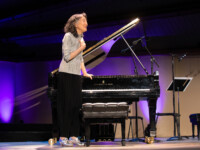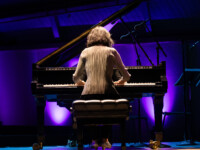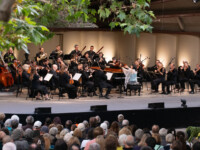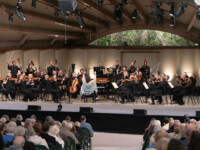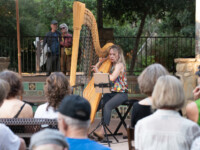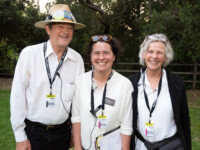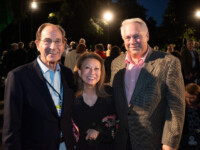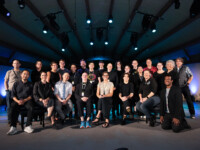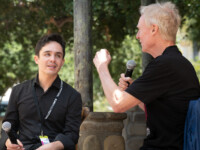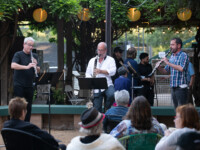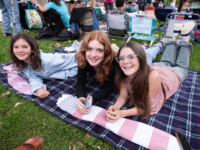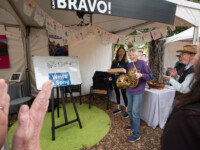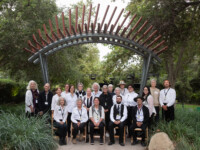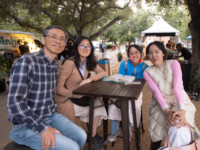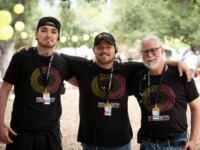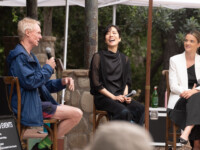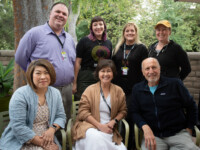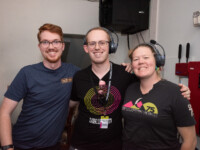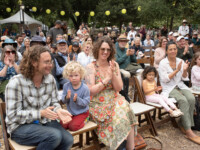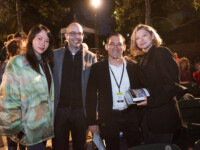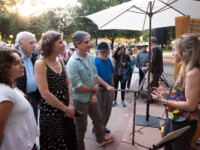OJAILIVE: 2024 Live Stream Replays
Since 2012, the Ojai Music Festival has expanded its global footprint building a worldwide audience and has deepened connections with patrons throughout the year with free Live Stream Broadcasts. The 78th Festival, June 6 to 9, continues this offering with acclaimed pianist Mitsuko Uchida as Music Director.
You can watch the free live streams of the Libbey Bowl concerts from the Festival’s home page which will begin Thu, June 6 at 8pm. The complete evening concerts will only be available at the time of the performance. UPDATE: Full morning concerts and highlights of the evening concerts are now available below and on our YouTube channel (7/1/24).
Stay updated on new Festival videos by subscribing to our YouTube channel.
For more context on this year’s Festival, enjoy these links:
THU June 6, 2024
Selections from the 8:00PM OPENING CONCERT
Libbey Bowl
Brentano String Quartet | Lucy Fitz Gibbon soprano
HAYDN String Quartet in C major, Op. 33, No. 3 (“Bird”)
SCHOENBERG Six Little Piano Pieces, Op. 19
SCHOENBERG String Quartet No. 2 in F-sharp minor, Op. 10
FRI June 7, 2024
10:00AM
Julie Smith Phillips harp | Jay Campbell cello | Sae Hashimoto percussion | Naomi Shaham double bass | Brentano String Quartet
KAIJA SAARIAHO Fall
HELMUT LACHENMANN Pression
SOFIA GUBAIDULINA Five Etudes
BARTÓK String Quartet No. 5
Selections from the 8:00PM concert
José Maria Blumenschein concertmaster and leader
Mahler Chamber Orchestra
STRAVINSKY Fanfare for a New Theater
WEBERN Five Movements for Strings, Op. 5
SCHOENBERG Chamber Symphony No. 1, Op. 9
SAT June 8, 2024
10:00AM
Ljubinka Kulisic accordion | Rick Stotijn double bass | Musicians of the Mahler Chamber Orchestra
JOHN ZORN Road Runner
MISSY MAZZOLI Dark with Excessive Bright
JOHN ADAMS Shaker Loops
Selections from the 8:00PM concert
José Maria Blumenschein concertmaster and leader | Aliisa Neige Barrière conductor | Vicente Alberola clarinet
DEBUSSY (arr. Benno SACHS) Prelude to the Afternoon of a Faun
KAIJA SAARIAHO Lichtbogen
ESA-PEKKA SALONEN Elegy (from kínēma)
SUN June 9, 2024
10:00AM
Alexi Kenney violin | Sae Hashimoto percussion | Ljubinka Kulisic accordion | Brentano String Quartet
BIBER Passacaglia for solo violin
KAIJA SAARIAHO Six Japanese Gardens
HAYDN From The Seven Last Words of Christ
SOFIA GUBAIDULINA In Croce
Selections from the 5:30PM concert
José Maria Blumenschein concertmaster and leader |
Mahler Chamber Orchestra
HAYDN Symphony No. 46 in B major, Hob. I:46
JÖRG WIDMANN Chorale Quartet (Choralquartett), version for chamber orchestra
2024 Press Coverage
Thank you for joining us at our 78th Festival, June 6-9, 2024. It was a glorious time to be in our communal festival experience, particularly in the company of our wondrous Music Director, Mitsuko Uchida. We were graced by her performances of extraordinary depth and insight along with the exhilaration of her partnership with the generous, brilliant musicians of the Mahler Chamber Orchestra and the 2024 featured artists.
Take a look at excerpts from the press.
“…we’re talking about Ojai, where open-minded audiences take in music accompanied by nature and snack on freshly picked pixie tangerines. Uchida might have seemed like a headliner, but this festival is about sharing the wealth.”
New York Times
“What’s so extraordinary about the Ojai Music Festival, now in its 78th year? Many things, actually, including its brevity (this year running June 6 through 9); challenging and often sharply contrasting programming; and a rich concentration of talent…”
Wall Street Journal
“Uchida’s playing was so uncompromisingly ethereal that its purpose seemed meant to open the listener’s mind a crack.”
Los Angeles Times
“In programming cahoots with artistic director Ara Guzelimian, Uchida managed to tap many important and lesser-heard musical touchpoints over the weekend, including paying respects to Saariaho, who died just more than a year ago. Her Lichtbogen, conducted here by her daughter Aliisa Neige Barriere, has a shimmering, evanescent atmosphere, mixing acoustic and electronic elements with abiding sensitivity…”
SB Independent
“The Ojai moment came during the cadenza of the second movement, Larghetto, when the piano, in its highest register, evokes the entrancing power of Papageno’s magic bells. A silence descended over Libbey Bowl that was so complete that the only sounds were the piano, the croaking of frogs, the rustling of crickets, and the songs of night birds. It was as if Uchida’s playing had somehow entranced us all.”
San Francisco Classical Voice
“[Alexi] Kenney, 30, who has seemed on the verge of stardom for some time, certainly became one of the highlights of this festival (he made his Ojai debut in 2021). Along with Kafka Fragments, he gave a brilliant solo performance, with innocuous abstract projections by visual artist Xuan, of another hour-long work called Shifting Ground, consisting of 11 pieces by various composers, also at the Ojai Valley School.
Classical Voice North America
2024 Festival Gallery
Concert Photos
Photos by Timothy Teague
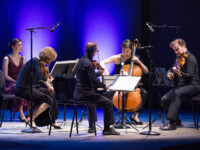
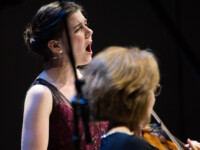
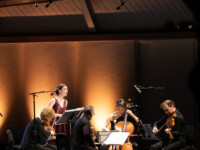
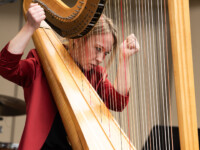
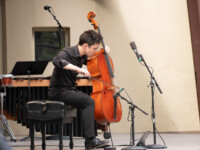
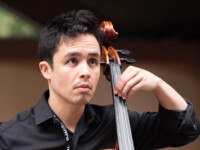
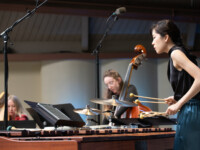
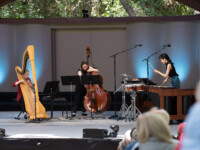
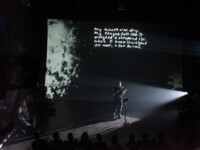
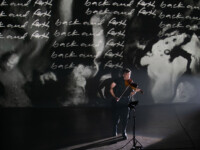
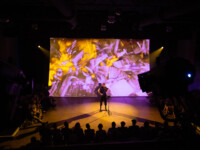
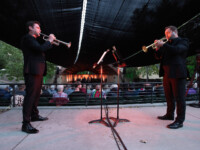
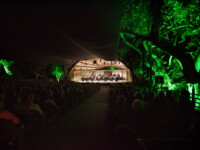
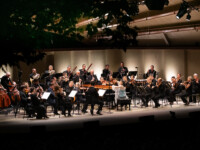
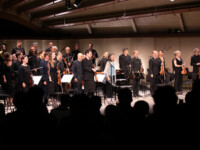


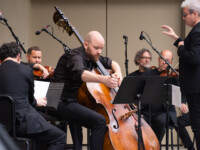
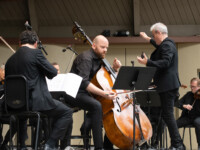
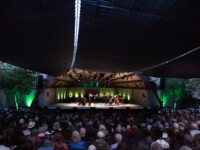
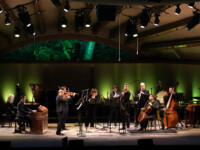
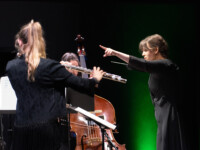
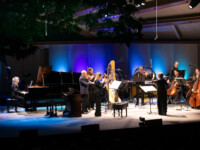
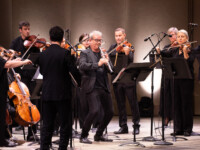
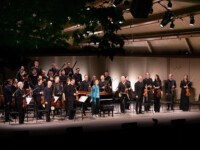

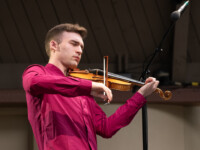
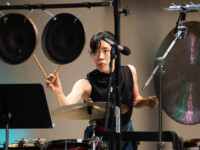
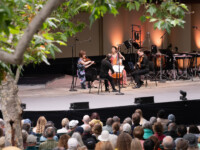

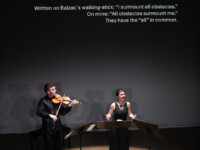
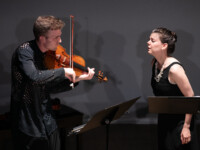
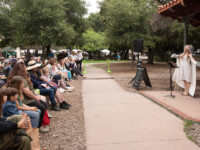
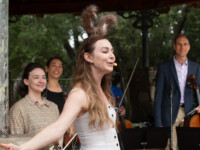
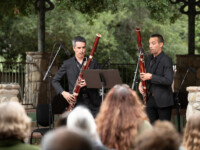
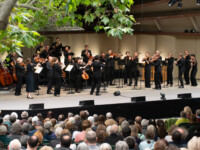
Ojai Music Festival Announces 2025 Music Director
“Claire Chase is one of the boldest, most inventive and irresistibly joyous musicians I have ever known. She is such a generative force in all that she does, embracing composers, audiences, and entire communities with generosity. She is the perfect match for Ojai’s spirit of adventure, and I can’t wait to imagine the possibilities together for the 2025 Festival!”
– Ara Guzelimian, Artistic and Executive Director
(April 10, 2024 – Ojai, California) – As the Ojai Music Festival anticipates the upcoming 78th Festival (June 6-9, 2024) with Music Director Mitsuko Uchida, Artistic and Executive Director Ara Guzelimian announces flutist Claire Chase as Music Director for the 2025 Festival. Since the late 1940s, the Ojai Music Festival’s tradition has been to welcome a new Music Director each year to ensure vitality and diversity in programming across Festivals. Initial details for Chase’s 2025 Festival (June 5 to 8, 2025) will be announced in June 2024.
“When Ara called me with the invitation, I nearly dropped the phone! The Ojai Festival has been a kind of dreamland for me since I was a kid growing up in Southern California, and I have the deepest affection for the audiences at Ojai – I don’t know that a more curious, adventurous, and open-eared group of listeners exists anywhere in the world. I’m tremendously excited to work with Ara to craft experiences that I hope will animate, complicate, and celebrate the connections between musics of the past and the beating-heart present,” shares Claire Chase.
Previously, Chase performed at the Ojai Music Festival with the International Contemporary Ensemble (ICE) in 2015 with that year’s Music Director Steven Schick, in 2016 with Music Director Peter Sellars, and in 2017 with Music Director Vijay Iyer.
Claire Chase, described by The New York Times recently as “the North Star of her instrument’s ever-expanding universe,” is a musician, interdisciplinary artist, and educator. Passionately dedicated to the creation of new ecosystems for the music of our time, Chase has given the world premieres of hundreds of new works by a new generation of artists, and in 2013 launched the 24-year commissioning project Density 2036. Now in its eleventh year, Density 2036 reimagines the solo flute literature over a quarter-century through commissions, performances, recordings, education, and an accessible archive at density2036.org. Chase co-founded the International Contemporary Ensemble in 2001, was named a MacArthur Fellow in 2012, and in 2017 was awarded the Avery Fisher Prize from Lincoln Center for the Performing Arts. Chase is currently Professor of the Practice of Music at Harvard University’s Department of Music, a Creative Associate at The Juilliard School, and a Collaborative Partner with Esa-Pekka Salonen and the San Francisco Symphony. For complete biographical information on Claire Chase, visit OjaiFestival.org.
Details of the 2025 Ojai Festival programming and artists will be announced in June 2024.
ARA GUZELIMIAN, ARTISTIC AND EXECUTIVE DIRECTOR
Ara Guzelimian is the Artistic and Executive Director of the Ojai Music Festival, having begun in that position in July 2020. The appointment culminates many years of association with the Festival including tenures as director of the Ojai Talks and as Artistic Director from 1992–97. Guzelimian stepped down as Provost and Dean of the Juilliard School in New York City in June 2020, having served in that position since 2007. He continues at Juilliard as Special Advisor.
Prior to the Juilliard appointment, he was Senior Director and Artistic Advisor of Carnegie Hall from 1998 to 2006. Guzelimian serves as artistic consultant for the Marlboro Music Festival and School in Vermont. He is a member of the steering committee of the Aga Khan Music Awards, the artistic committee of the Borletti-Buitoni Trust in London, and a board member of the Amphion and Pacific Harmony Foundations. He is also a member of the music visiting committee of the Morgan Library and Museum in New York City. In 2020, Guzelimian was appointed to the advisory panel of the Birgit Nilsson Foundation in Sweden.
Previously, Guzelimian held the position of Artistic Administrator of the Aspen Music Festival and School in Colorado, and he was long associated with the Los Angeles Philharmonic, first as producer for the orchestra’s national radio broadcasts and, subsequently, as Artistic Administrator. Guzelimian is editor of Parallels and Paradoxes: Explorations in Music and Society (Pantheon Books, 2002), a collection of dialogues between Daniel Barenboim and Edward Said. In September 2003, he was awarded the title Chevalier des Arts et des Lettres by the French government for his contributions to French music and culture.
OJAI MUSIC FESTIVAL
The Ojai Music Festival represents an ideal of adventurous, open-minded, and openhearted programming in the most beautiful and welcoming of settings, with audiences and artists to match its aspirations. Now in its 78th year, the Festival remains a creative laboratory for thought-provoking musical experiences, bringing together innovative artists and curious audiences in an intimate, idyllic outdoor setting. Each Festival’s narrative is guided by a different Music Director, whose distinctive perspectives shape programming — ensuring energized festivals year after year.
Throughout each year, the Ojai Music Festival contributes to Southern California’s cultural landscape with in-person and online programming as well as robust educational offerings that serve thousands of public-school students and seniors. The organization’s apex is the world-renowned Festival, which takes place over four days in Ojai, a breathtaking valley 75 miles from Los Angeles, which is a perennial platform for the fresh and unexpected. During the immersive experience, a mingling of the most curious take part in concerts, symposia, free community events, and social gatherings. The intimate Festival weekend, considered a highlight of the international music summer season, welcomes up to 5,000 patrons and reaches exponentially more audiences worldwide through streaming and broadcasts of concerts and discussions throughout the year.
Since its founding in 1947, the Ojai Music Festival has presented expansive programming in unusual ways with an eclectic mix of new and rarely performed music, as well as refreshing juxtapositions of musical styles. Through its signature structure of the Artistic Director appointing a different Music Director each year, Ojai has presented a “who’s who” of music including Mitsuko Uchida, Rhiannon Giddens, AMOC* (American Modern Opera Company), Vijay Iyer, Patricia Kopatchinskaja, and Barbara Hannigan in recent years; throughout its history, featured artists have included Aaron Copland, Igor Stravinsky, Michael Tilson Thomas, Kent Nagano, Pierre Boulez, John Adams, Esa-Pekka Salonen, Robert Spano, Pierre-Laurent Aimard, David Robertson, Eighth Blackbird, George Benjamin, Dawn Upshaw, Leif Ove Andsnes, Mark Morris, Jeremy Denk, Steven Schick, Matthias Pintscher, and Peter Sellars.
EXPERIENCE THE 78TH OJAI MUSIC FESTIVAL, JUNE 6-9, 2024
The 78th Ojai Music Festival, June 6 to 9, 2024, welcomes as Music Director pianist Mitsuko Uchida, one of the most universally admired artists of our time. Mitsuko Uchida last performed at the 2004 Festival and was co-music director in 1998.
Uchida, who will perform each Festival evening in works by Schoenberg and Mozart, welcomes 2024 collaborators the Mahler Chamber Orchestra, Brentano String Quartet, violinist Alexi Kenney, cellist Jay Campbell, harpist Julie Smith Phillips, soprano Lucy Fitz Gibbon, percussionist Sae Hashimoto, accordionist Ljubinka Kulisic and bassist Rick Stotijn.
Works By Kaija Saariaho are woven throughout the 2024 Festival, including Dreaming Chaconne, Fall, Six Japanese Gardens, and Lichtbogen, conducted by Saariaho’s daughter Aliisa Neige Barriere. Highlights of the 2024 Festival also include music of John Adams, Bartók, Biber, Cage, Debussy, Sofia Gubaidulina, Kurtág, Helmut Lachenmann, Missy Mazzoli, Esa-Pekka Salonen, Stravinsky, Jörg Widmann, and John Zorn.
In collaboration with Baryshnikov Arts, Shifting Ground features violinist Alexi Kenney and video projections by Xuan, juxtaposing Baroque works by Bach and Matteis, with recent music by Kaija Saariaho, Angélica Negrón, Paul Wiancko, and Salina Fisher. The 2024 Festival integrates music from both the First and Second Viennese Schools, from Haydn and Mozart to Berg, Webern, and multiple works by Arnold Schoenberg in honor of the 150th Anniversary of his birth.
Single tickets and day passes to the 2024 Festival are available online at OjaiFestival.org or by calling (805) 646-2053. Follow Festival updates at OjaiFestival.org.
# # #
2024 Concert Program Notes
Thursday, June 6, 2024 | 8:00pm
Libbey Bowl
Brentano String Quartet: Mark Steinberg and Serena Canin violins, Misha Amory viola, Nina Lee cello | Mitsuko Uchida piano | Lucy Fitz Gibbon soprano
Joseph HAYDN
String Quartet in C major, Op. 33, No. 3 (“Bird”)
I. Allegro moderato
II. Scherzo: Allegretto
III. Adagio ma non troppo
IV. Finale: Rondo: Presto
Brentano String Quartet
Arnold SCHOENBERG
Six Little Piano Pieces, Op. 19
I. Leicht, zart (light, delicate)
II. Langsam (slow)
III. Sehr langsam (very slow)
IV. Rasch, aber leicht (brisk, but light)
V. Etwas rasch (somewhat brisk)
VI. Sehr langsam (very slow)
Mitsuko Uchida piano
INTERMISSION
Wolfgang Amadeus MOZART
Fantasia in D minor, K. 397
Mitsuko Uchida piano
Arnold SCHOENBERG
String Quartet No. 2 in F-sharp minor, Op. 10
I. Mässig (moderato)
II. Sehr rasch (very fast)
III. Litanei (“Litany”): Langsam (slow) (poetry of Stefan George)
IV. Entrückung (“Rapture”): Sehr langsam (very slow) (poetry of Stefan George)
Brentano String Quartet | Lucy Fitz Gibbon soprano
Wit, Fantasy, Rapture
Only a little more than a century and a quarter separates the quartets by Haydn and Schoenberg that frame our opening program, and both works emerged from the same Austro-German tradition. Yet being able to hear, on the same program, the shift in what had been thought musically possible by the time we reach the final movement of the Schoenberg allows us to relive one of the most momentous turning points in the history of Western music.
Schoenberg’s Second Quartet embodies a musical Copernican Revolution in its quest for “the emancipation of the dissonance” — that is, the dissolution of the laws and conventions of tonal harmony that had served as the bedrock for that tradition. (The presence of a solo soprano alongside the classical quartet of string players is merely one aspect of the work’s innovations.) The fourth and final movement, in which this rupture dramatically occurs, represents a pivotal moment for the birth of the Modernist outlook.
Modernism’s unfolding — in particular, its embrace of the so-called atonality (never a very helpful word) that Schoenberg transformed into a lingua franca for 20th-century composers — would be experienced by many as traumatic and destabilizing. Yet the composer described the introductory music to the Second Quartet’s notorious finale in terms of the poetic vision he chose to set: “becoming relieved from gravitation — passing through clouds into thinner and thinner air, forgetting all the troubles of life on earth …”
But Haydn, too, must be credited with radically changing perceptions of what the language of music can encompass. One of the leading architects of Classical style, Haydn depicted a stunning negation of the order on which it is based in the evocation of Chaos in his late masterwork The Creation.
The dichotomy becomes possible only through the deliberate subversion of tonal rules and the expectations established by Classical style. Haydn continually generates ideas from the tension between conventional patterns and his subtle ways of undermining them — the driving force of this composer’s much-lauded “wit.” With his tirelessly innovative output of string quartets and symphonies, Haydn developed genres principally meant for entertainment into vehicles for sophisticated contemplation (without ever losing sight of the former).
It was only with the Op. 33 set, written in 1781 — when he was approaching 50 — that Haydn actually began using the term string quartet (preferring the term divertimento prior to that). He announced that these quartets had been written “in a new and special way.” The nickname “Bird” refers to the imaginary evocation of avian chirping in the first movement, but we can also hear the wonderful opening of the C major Quartet as a teasing exploration of tonality that alternately seizes and lets go of the home key in surprising feints.
Mozart must have been especially enchanted by the contrast in mood between the Adagio’s intimacy and the unbuttoned comedy of the final movement. Haydn was one of the few living composers he deeply admired, and the two became friends after Mozart had settled in Vienna in 1781. Each welcomed the influence of the other.
The Fantasia in D minor dates from 1782, the same year Haydn’s Op. 33 quartets were published, but was likely left unfinished. Only after Mozart’s death was the manuscript published. For the missing measures at the end of the piece, Mitsuko Uchida supplies her own ending based on the opening. The Fantasia’s tempo changes several times, suggesting an improvisational attitude: At the heart is an aria-like Adagio of cutting pathos. The tonal shift to D major in the Allegretto conclusion has the effect not so much of a resolution of the grief preceding it as of a past joy recalled.
Uchida oscillates with ease between the idioms of the First and Second Viennese Schools. Just five minutes or so in duration, the Six Little Piano Pieces comprising Schoenberg’s Op. 19 can seem, in her hands, to “anticipate” the variability of Mozart’s Fantasia. These hermetic, freely atonal miniatures dating from early 1911 — the first five were composed in a single day — condense implicitly longer forms (such as an entire aria in No. 5) into aphorisms. Schoenberg’s later systematic codification of his ideas led to the charge that it is overly “cerebral,” but this music vibrates with emotional intensity and expression — above all in the last piece, No. 6, written independently in 1911 in response to the death of his admired Mahler.
Turmoil in Schoenberg’s personal life is inseparable from the composition of the epochal Second Quartet. He started writing it in 1907, when he was experiencing marital strain with his first wife, Mathilde, along with a kind of separation anxiety over the departure of his champion Mahler for the New World. The strain worsened, and Mathilde left her husband in 1908 to pursue a relationship with the Expressionist painter Richard Gerstl. After Schoenberg persuaded Mathilde to return, Gerstl committed suicide. The painter’s boldly original work, meanwhile, left a strong mark on the composer.
Ironically, Schoenberg seems on one level to be moving into a more Classical direction in this score. While his First String Quartet is cast in a large-scale single movement, the Second is a shorter composition that reverts to the familiar four-movement design, the first three of which adhere to the paradigm of a sonata form first movement, a scherzo, and a slow movement. The final movement, the longest, omits a key signature (though Schoenberg set the others in F-sharp minor, D minor, and E-flat minor, respectively).
Schoenberg’s sardonic humor emerges in the scherzo, whose middle section quotes the Viennese folk song “O du lieber Augustin.” Originating in the plague years, the song’s phrase “alles ist hin!” (“It’s all over!”) might serve as an epigram for this turning point in musical and cultural history.
In his Transfigured Night of 1899— another piece informed by his relationship with Mathilde — Schoenberg had combined poetic inspiration with string chamber music. But he actually incorporates texts by the German Symbolist poet Stefan George (1868- 1933) into the last two movements of the Second Quartet. Adding a soprano was all the more provocative, since the string quartet was understood as the quintessentially instrumental form of discourse. More than Beethoven in the Ninth, Mahler’s song movements in the Wunderhorn symphonies would seem to be the pertinent model for Schoenberg.
The slow Litany movement unfolds as a set of variations — not on a theme per se, but on fragments and themes derived from the opening movement and the scherzo. George’s text expresses a mood of gloom, grief, and longing that casts a retrospective light on the preceding movements. Entrückung (“Rapture”), the text used in the finale, opens with the line Ich fühle luft von anderem planeten (“I feel air from another planet”).
Conventional tonality is affirmed by the “gravitational” pull of the tonic, but in the brave new world into which Schoenberg ventures here, the loss of that compass triggers an exhilarating sense of weightlessness. Even with the return to F-sharp major at the conclusion, the sensation of a radiantly floating vision of a new reality lingers.
—THOMAS MAY
Friday, June 7, 2024 | 8:00am
Zalk Theater, Besant Hill School
OJAI DAWNS
Jay Campbell cello | Sae Hashimoto percussion | Ljubinka Kulisic accordion
Giuseppe COLOMBI
Kaija SAARIAHO
Helmut LACHENMANN
Helmut LACHENMANN
Sofia GUBAIDULINA
Ciaccona
Jay Campbell cello
Dreaming Chaconne
Jay Campbell cello
Intérieur I
Sae Hashimoto percussion
Toccatina
Jay Campbell cello
In Croce
Jay Campbell cello | Ljubinka Kulisic accordion
Sound Production
Last night’s opening concert invited questions about what it means to evolve and innovate within a shared language — the system of Western tonality as shaped and challenged by Haydn, Mozart, and Schoenberg. We continue this morning with a trio of contemporary composers who interrogate our assumptions about instruments themselves and the kinds of sounds they produce.
We open the program with Kaija Saariaho’s Dreaming Chaconne, her contribution to a project she helped to organize to celebrate the 50th birthday of her compatriot, the Finnish cellist Anssi Karttunen. A total of 31 composers from 12 countries were invited to create a variation on one of the earliest pieces known to be written for solo cello: a chaconne by the Italian composer Giuseppe Colombi (1635-94) for an earlier and larger form of the cello called a basso (which Jay Campbell plays as a prelude to Saariaho’s variation). None of the composers was aware of which colleagues had also been invited to participate — hence the title Mystery Variations for the overall project.
Saariaho’s fabric of slow trills between stopped notes and natural harmonics, feathery slides, and tremolos forms a sonic veil behind which the shape of Colombi’s chaconne remains only as a spectral memory.
The eminent German composer Helmut Lachenmann, who was invited by Mitsuko Uchida to a residency at the Marlboro Music School and Festival last year, has for decades pursued his fascination with what he terms the “anatomy” of sound and its production. Intérieur I is a breakthrough work from the mid-1960s that embodies Lachenmann’s radically new focus on composition as the production of sounds and the conditions under which this occurs. Percussion instruments had been a kind of last timbral frontier for Modernism. But Lachenmann’s approach defamiliarizes the musician’s and audience’s relationship with the panoply of largely untuned percussion instruments.
Various types of drumsticks, mallets, even the player’s hands are not used in the expected ways but produce odd rubbings and ghostly tremolos: a kind of music “in which the sound events are chosen and organized so that the manner in which they are generated is at least as important as the resultant acoustic qualities themselves,” as the composer described his concept of instrumental musique concrète.
The mindfulness Lachenmann demands is immediately apparent in the briefer and later Toccatina, originally written for solo violin but performed here in Jay Campbell’s arrangement for cello. Referring to the classical toccata, the title plays on the idea of instrumental virtuosity through dexterous touching and fingering of the instrument. (The Italian root toccare, “to touch,” itself draws attention to the physical production of sound.)
Lachenmann adapts percussive effects in mesmerizing ways, asking the player to tap the metal screw of the vertically held bow onto the instrument’s strings (and even includes an extra clef detailing the positions of these contact points). Campbell likens performing Toccatina to undertaking “a very intense tightrope walk. The sound is so tiny and fragile. It’s very playful — and dangerous.”
Sofia Gubaidulina came of age as an outsider in the Soviet Union — an artist of half-Russian, half-Tatar origins — which encouraged her openness to exploring unconventional sonorities. Many of her compositions reconsider the raw material— the physical manifestations — of musical facts: pulses, breaths, tunings. At the same time, Gubaidulina’s Russian Orthodox faith has inspired her to interpret these “facts” in spiritual and even mystical terms.
In Croce incorporates the Christian symbol indicated by the title (“On the Cross”) into the music itself through a series of literal and figurative “crossings” of register and texture between the instruments: cello and organ in the original version of 1979 and cello and bayan (Russian button accordion) in the later arrangement we hear. But the surface plan of this drama is not as schematic as a simple summary might indicate. Gubaidulina encourages a suspension of our sense of ordinary time as we enter this labyrinth of fluctuating intensities.
Gubaidulina extracts a remarkable variety of colors from the unusual pairing of instruments, stretching each to its limits. The bayan begins in a lofty, diatonic A major space, while the cello emerges from the depths on a low E, striving to break free with anguished chromatic slides. They gradually exchange positions, reaching a climax where the two lines cross. The piece ends with the cello sounding almost flute-like in its otherworldly high perch against the deep rumbling of the bayan far below — where the cello, in a final gesture, again meets its counterpart via a descending glissando.
—THOMAS MAY
Friday, June 7, 2024 | 10:00am
Libbey Bowl
Julie Smith Phillips harp | Jay Campbell cello | Sae Hashimoto percussion | Rick Stotijn double bass
Brentano String Quartet: Mark Steinberg and Serena Canin violins, Misha Amory viola, Nina Lee cello
Kaija SAARIAHO
Fall
Julie Smith Phillips harp
Helmut LACHENMANN
Pression
Jay Campbell cello
Sofia GUBAIDULINA
Five Etudes
I. Largo
II. Allegretto
III. Adagio
IV. Allegro disparate
V. Andante
Julie Smith Phillips harp | Sae Hashimoto percussion | Rick Stotijn double bass
Béla BARTÓK
String Quartet No. 5
I. Allegro
II. Adagio molto
III. Scherzo: alla bulgarese
IV. Andante
V. Finale: Allegro vivace
Brentano String Quartet
Incorrect Paths
Over the past decade, Mitsuko Uchida has invited three of the four composers on this morning’s program to participate in the composer residency program at the Marlboro Music Festival — artists she admires as “some of the most compelling musical thinkers of our time.” (Music by two other former composers-in-residence — György Kurtág and Jörg Widmann — can also be heard on Sunday’s programs.)
The late Kaija Saariaho in fact returned to collaborate with the Marlboro musicians over two back-to-back summers in 2014-15. Fall is an arresting example of Saariaho’s ability to convey an assemblage of freely associated images through the interchange of acoustic and electronic sounds and a poetics of timbre. Scored for solo harp and electronics, Fall is the second-to-last section of her ballet score Maa (Finnish for “land,” “earth,” “world”). In lieu of a plotted scenario, Maa explores themes of “passing from one state to another; opening doors, gates, falling, crossing the Water,” the composer writes. Fall in particular evokes “an idea about falling into an underworld.” It traces an arc that begins in the harp’s highest register, where the soloist is instructed to play “sorrowfully, always with expression,” and culminates in a violently downward-sweeping glissando.
What associations do we bring to each instrument, even before a note emerges? In his pivotal early piece Pression for solo cello, the German composer Helmut Lachenmann challenges us to radically rethink what the cello represents — and, in the process, aims to provoke us out of complacent “habits” in approaching the phenomenon of a performance. Lachenmann uncovers “such a subtle spectrum of pitch to noise that, by the end of the piece, you start hearing noises in interesting new ways,” cellist Jay Campbell points out. “When I play it, I feel like I’m discovering the cello again.”
Pression intensifies our focus on the physicality of the cello and of the musician’s relationship with this body of wood and tense strings stretched over a bridge, of finger flesh versus bow wood and hair. Only at the center of the piece is a “normal” note produced in the expected way. Even the score is unconventional — not the code for an already finished composition but a graphical prescription illustrating what actions the cellist is to take.
Sofia Gubaidulina is similarly represented by an important early work. In fact, she has characterized Five Etudes for harp, double bass, and percussion from 1965 as the work in which she first found her distinctive voice. Born in the great crossroads city of Kazan on the Volga River in the Tatar Republic, she came of age in the Soviet Union and took to heart the words of advice she received from Dmitri Shostakovich, who led her examination committee when she graduated from the Moscow Conservatory in 1959: “Don’t be afraid to be yourself. My wish for you is that you should continue on your own, incorrect path.”
Gubaidulina’s originality in Five Etudes is apparent in both the formal design and the unusual soundscape. Instead of a traditional genre — she has no interest in the gradual improvement of technique suggested by the conventional etude — the work comprises five miniatures in different tempos. With her configuration of harp, double bass, and tuned and untuned percussion, Gubaidulina constructs an intriguing variety of sonic pictures framed by mysterious double bass pizzicati that seem to emerge from deep in the earth. She evokes the energy of improvised jazz (second piece) and of a manic scherzo (in the fourth piece, a “desperate Allegro”), while the central Adagio brings to mind an archaic ritual or elegy, eventually merging with silence. “From this moment, I realized that I would pay no attention at all to anybody else,” Gubaidulina remarked of Five Etudes. “I would do as I liked.”
The interest in the materiality of instruments and their sonorities manifested by the first three works on our program is mirrored by the string quartets of Béla Bartók. His six contributions to the genre span three decades, mapping the Hungarian composer’s development as an artist. They form a cycle that is regularly compared to Beethoven’s quartets, a pinnacle of formal, expressive, and technical innovation.
The tactile energy of the “Bartók” or “snap” pizzicato — in which the string(s) is plucked vertically and released so powerfully that it rebounds against the fingerboard — is a well-known example of the palette of “special effects,” along with exaggerated sliding, playing with the wood of the bow, raspy scratching at the bridge, and other techniques that are integrated into the language of the quartets. Bartók’s tireless research into Eastern European and North African folk music informs myriad aspects of the quartets, each of which inhabits a distinctive world.
The String Quartet No. 5, the only one of the six commissioned for an American audience, originated when the legendary music patron Elizabeth Sprague Coolidge, its dedicatee, requested Bartók to contribute a work for a chamber music festival she was sponsoring. The composer, who would reluctantly emigrate to the United States in 1940, was still living in Budapest and reportedly isolated himself to complete the score within a month in the late summer of 1934, at the beginning of an especially productive creative period; the Kolisch Quartet gave the premiere at the Library of Congress in 1935.
Regarded as less overtly experimental and more extroverted than its predecessors, the Quartet No. 5 unfolds in five movements showing Bartók’s ongoing fascination with arch form: Revolving around a lively scherzo at the center are two slow movements, which themselves are framed by two fast-paced outer movements. The opening Allegro, in turn, is shaped as a microcosm of arch form, with the material from the exposition reversed when presented again in the reprise. Bartók posits an alternative to Schoenberg’s 12-tone method in his novel use of a melody-centered chromaticism.
Another Bartók signature, the composer’s so-called “night music” style, comes to the fore in the mysterious atmospheres and arresting timbral vocabulary of the slow movements. The central Scherzo adapts the uneven rhythmic patterns and vigor of Bulgarian folk music. A vivid sense of combustible energy drives the finale. Punctuated by sudden pauses, this vehement music swerves into an enigmatic episode toward the end that renders the material in an out-of-tune, amusement-park-like parody.”
—THOMAS MAY
Friday, June 7 & Saturday June 8 | 3:30pm
Greenberg Center
SHIFTING GROUND
Alexi Kenney violin | Xuan visual art
Rafiq BHATIA
J.S. BACH
Paul WIANCKO
Descent
Allemande from Violin Partita No. 2 in D minor, BWV 1004
Allemande from X Suite
—
Angélica NEGRÓN
The Violinist for violin and electronics, story by Ana Fabrega
—
J.S. BACH
Nicola MATTEIS
Kaija SAARIAHO
Salina FISHER
Grave from Violin Sonata No. 2 in A minor, BWV 1003
Alia Fantasia
Nocturne for solo violin
Hikari for solo violin
—
Mario DAVIDOVSKY
Synchronisms No. 9 for violin and tape
—
Matthew BURTNER
Elegy (Muir Glacier 1889-2009) for violin and glacier sonification
J.S. BACH
Chaconne from Violin Partita No. 2 in D minor, BWV 1004
Artist’s Statement by Alexi Kenney
I must have been about 10 years old when I first heard J.S. Bach’s Chaconne, introduced to me by my then-teacher Jenny Rudin. I remember being first overwhelmed by its magnitude, its complexity, its difficulty, then enchanted by its mysterious power to hold me enraptured and transported for a full 13 minutes.
Over the years, the Chaconne has come to occupy maybe the biggest and most important place of any piece of music in my life: It provides a meditative landscape for me to think through creative thoughts; it continues to be the piece I turn to to get myself back into playing shape after taking breaks away from the violin; and, several years ago, it was the only way that seemed to make sense to process the death of the same teacher who had taught it to me when I was young.
Through my lifetime of loving the Chaconne came the idea that inspired Shifting Ground: Bach is connected to everything. Beyond his music’s most important capacity to speak straight to the soul, Bach’s influence ripples through time and transcends genre. The structures, harmonies, and counterpoint he mastered are present in just about every genre of music we listen to today, and certainly have lived in the consciousness of almost all classical composers and performers who came after him.
Shifting Ground is a program whose titular word ground bears homage to Bach’s era, the Baroque, in which a bass line (also called a ground bass) is repeated with embellishments and variations on top of it. This is the form that the Chaconne takes over the span of its 13 minutes: a constant cycling and recycling of the same bass line, on top of which Bach constructs a whole life.
This program is also an excavation of music’s roots, and an observation of their manifestation and development through time. It opens with Rafiq Bhatia’s Descent, where the solo violin dangerously careens down the entire length of its register until it hits rock bottom. Kaija Saariaho, Paul Wiancko, and Salina Fisher all intentionally used Bach as a jumping-off point for their works on this program. Nicola Matteis was Bach’s contemporary, yet I feel as though his spiritual and almost ambient music could easily be written today. Angélica Negrón’s raucous and beautiful nightmare The Violinist is a narrated short story that provides a moment of respite and humor in the program, while Mario Davidovsky explodes Bach’s world into outer space, creating chamber music between violin and synthesizer. In the final piece before the Chaconne, Matthew Burtner’s Elegy ruminates on the impermanence and fragility of our natural surroundings, placing the violin over a field recording of Muir Glacier as it slowly melts due to climate change. And finally the Chaconne, a sort of extension of all that we have heard, and a final meditation on humanity itself.
Friday, June 7, 2024 | 8:00pm
Libbey Bowl
Mahler Chamber Orchestra
Mitsuko Uchida piano and director
José Maria Blumenschein concertmaster and leader
Igor STRAVINSKY
Fanfare for a New Theater
Matthew Sadler and Alexander Freund trumpets
Anton WEBERN Five Movements for Strings, Op. 5
I. Heftig bewegt (violently animated)
II. Sehr langsam (very slow)
III. Sehr bewegt (very animated)
IV. Sehr bewegt (very animated)
V. In zarter Bewegung (with gentle movement)
Arnold SCHOENBERG
Chamber Symphony No. 1, Op. 9
INTERMISSION
Wolfgang Amadeus MOZART
Piano Concerto in E-flat major, K. 482
I. Allegro
II. Andante
III. Allegro
Mitsuko Uchida piano and director
Creative Outbursts
Igor Stravinsky knew how to call an audience to attention. His Fanfare for a New Theater has the honor of throwing the first musical pitch for this evening’s concert. But this is no standard-issue fanfare. Written for the opening of the New York State Theater at Lincoln Center in 1964 (since renamed the David H. Koch Theater), the piece is of late vintage and represents the composer’s late period, when he had come to admire and experiment with the serial method of Arnold Schoenberg and his followers.
More than a matter of new methods, Stravinsky’s shocking embrace of a personal approach to serialism had philosophical implications, challenging the longstanding polarization of 20th-century Modernism into pro-Stravinsky versus pro-Schoenberg camps.
Two trumpets, less than a minute of music: Fanfare manages, with such minimal means, to compress an astonishingly complex yet vivid sonic picture of unity and individuality, of festivity both solemn and playful.
It was, specifically, his admiration of the music of Schoenberg’s student Anton Webern that brought Stravinsky around to the untapped potential of the “method of composing with 12 tones which are related only with one another” (as Schoenberg once defined his 12- tone serial technique). Webern himself internalized, with an uncanny intensity, what he learned from his teacher but transformed it into a distinctive language of his own.
Five Movements for Strings, an arrangement for string orchestra from 1929 of Webern’s Five Movements for String Quartet, was his first contribution to the genre. He had composed the latter in 1909, the year after Schoenberg’s epochal String Quartet No. 2 (which was performed on last night’s opening program). Webern had also concluded his formal study with his mentor in 1908 and soon adopted his own approach to the unrestricted atonality that Schoenberg was pioneering. For example, Webern pushed the principle of brevity and compression to an extreme, developing a signature aphoristic style that his teacher likened to “a novel in a single gesture, a joy in a breath.”
The range of expressive and sonic terrain encompassed by Five Movements certainly belies the composition’s relatively brief duration: the fifth movement, with its poetry of spareness, is the longest but lasts only about four minutes; the shortest, at the center, is less than a minute. Webern mimics aspects of a Classical long-form work with an opening allegro based on contrasts; a muted slow movement; a skittish scherzo; another, rather unworldly, slow movement (calling for ghostly sul ponticello); and a finale that seems to dramatize the dissolution of organized sound into silence “with tender animation.”
Schoenberg responded to the new century’s pervasive sense of artistic crisis with an astonishing outburst of creativity. His ongoing quest to advance the musical tradition to which he felt so profoundly connected led to his experiments with a language no longer tethered to the gravitation toward a tonal center — to what became known as atonality. A pivotal work tending in this direction is the Chamber Symphony No. 1 of 1906. “I believed I had now found my own personal style of composing … and that a way had been shown out of the perplexities in which we young composers had been involved,” Schoenberg recalled, describing the initial joy he felt after completing the score. But he soon found this assessment to be “as lovely a dream as it was a disappointing illusion.” The Chamber Symphony thus sets the stage for the even more radical breakthroughs of works like the String Quartet No. 2 two years later. It is not “atonal” (Schoenberg anchors the piece in E major) but it does rely on a harmonic vocabulary that is tonally ambiguous.
By scoring the work for 15 soloists, Schoenberg renounces the gigantizing tendencies of late Romanticism (though he had yet to complete his massive oratorio Gurre-Lieder) in favor of concision and compression. Time is compressed as well: the dimensions of a full-scale symphony are concentrated into 20 or so minutes, though Schoenberg maximizes the sense of expressive content. Architecturally ingenious, the Chamber Symphony can be parsed as a seamless symphony incorporating a first movement (brief introduction — another rousing fanfare idea to compare with Stravinsky’s — and exposition), a scherzo and trio, a slow movement, and a finale (presenting a recapitulation) — or as a single-movement sonata with interludes bridging the main sections.
Schoenberg referred to the “centrifugal” tendencies of his thematic material. Through its restlessly overlapping gestures and polyphonic adventures, the Chamber Symphony conveys a sense of hyperactively firing musical synapses — as if the composer were trying to portray the process of evolution itself. The effect is as exhausting as it is exhilarating.
Dating from December 1785, an especially fecund period of Mozart’s piano concerto production, the Piano Concerto in E-flat major tends to be eclipsed by the two concertos he had written earlier that year. But K. 482 explores a unique soundscape of its own by replacing the oboes with the mellow sonority of clarinets and engaging the woodwinds in elegantly intimate conversations with the piano soloist, who makes her entrance playing material that will have an integral role in the development of the first movement. Mozart fills the canvas of this spacious opening movement with a prodigal abundance of thematic and lyrical ideas (in contrast with Haydn’s tendency towards the thrifty use of material).
The shift to a minor key (C minor) for the variation-based Andante initially comes as a surprise but, in Mozart’s hands, gives the concerto an indelible emotional depth. His obsession with opera also leaves a mark. Mozart was already hard at work composing the first of his collaborations with Lorenzo Da Ponte, Le Nozze di Figaro (which would be premiered in the following May). Something of the bittersweet Eros that pervades Figaro might be said to flavor the Andante as well.
Another surprise is the gently sensuous, minuet-like andantino episode that arrives in the middle of the catchy finale — more evidence of the Figaro sound waiting in the wings. An amiable nod to the temperament of Mozart’s friend Haydn, who understood his younger peer’s genius like no one else, appears near the very end — yet in a touch that fully reaffirms Mozart’s own personality, as composer and pianist alike.
—THOMAS MAY
Saturday, June 8, 2024 | 10:00am
Libbey Bowl
Ljubinka Kulisic accordion | Rick Stotijn double bass
Musicians of the Mahler Chamber Orchestra
John ZORN
Road Runner
Ljubinka Kulisic accordion
Missy MAZZOLI
Dark with Excessive Bright
Rick Stotijn double bass | José Maria Blumenschein concertmaster and leader
Musicians of the Mahler Chamber Orchestra
John ADAMS
Shaker Loops
Shaking and Trembling
Hymning Slews
Loops and Verses
A Final Shaking
Musicians of the Mahler Chamber Orchestra: Alexandra Preucil, May Kunstovny, and Naomi Peters violins, Yannick Dondelinger viola, Stefan Faludi and Christoph Richter cellos, Naomi Shaham double bass
Changing Contexts
However straightforward they may seem on the surface, musical quotations can open up astonishingly complex, even subversive dimensions. Like the language of Western tonal harmony itself, their effect in a composition is deeply reliant on context. Schoenberg’s famous allusion to a Viennese folk song in the second movement of his landmark String Quartet No. 2, for example, has generated endless interpretations.
A lot of fun is to be had with the restless collage of quotations that the uber-prolific John Zorn has jam-packed into Road Runner. But their manic velocity and the randomness give the piece a surreal (if not sinister) edge. The epitome of the downtown New York composer, Zorn composed Road Runner in 1985, the year of his breakthrough album of Ennio Morricone covers, The Big Gundown, (and a decade before launching his experimental Tzadik Records label).
No interpretation can be the same, since Zorn loads the piece with options for improvising and “noodling” on the accordion. Illustrated by pasted-on cutouts of images of the Warner Brothers cartoon characters Wile E. Coyote and Road Runner, the graphic score comprises 23 short, block-like sections that proceed spasmodically, like a stop-start animated film. The quotes shift abruptly from classical rep (“a la Liszt Hungarian Rhapsody”) to pop culture (the Dragnet theme) and dance styles, with instructions to “make mistakes, drunkenly” or “knock on door” mixed in among other frenzied gestures.
“Dark with excessive bright thy skirts appear, / Yet dazzle Heaven, that brightest Seraphim / Approach not, but with both wings veil their eyes”: Along with her allusions to Baroque style, Missy Mazzoli’s composition takes its title from a literary quotation — namely, this passage from the beginning of Book III of Paradise Lost, in which Milton attempts to describe the ineffable by depicting God.
Another quote is in order: “Her phrases remind me of a great novelist’s sentences, even those of my favorite novelist, Henry James, in the way that they seem always to be searching, falling back, leaping forward; in their hesitation and their charge, their faltering and their determination.” — from the writer Garth Greenwell, who was enlisted to write the liner notes for the BIS recording of the solo violin version of Dark with Excessive Bright.
Musical America’s Composer of the Year in 2022, Mazzoli has earned acclaim in particular as an opera composer: Her remarkable Breaking the Waves received a new production this spring at Detroit Opera, and she is at work on a Met commission to adapt George Saunders’s Lincoln in the Bardo. Mazzoli has become a sought-after voice in the concert hall as well, receiving commissions from such ensembles as the Los Angeles Philharmonic, Chicago Symphony, National Symphony, and, in the case of Dark with Excessive Bright, the Australian Chamber Orchestra, which co-commissioned the piece in 2018 with the London-based Aurora Orchestra.
Initially written for ACO’s principal double bassist Maxime Bibeau, Dark with Excessive Bright shows Mazzoli’s fascination with the drama inherent in the concerto format. The phrase by Milton that she chose as her title “is a surreal and evocative description of God, written by a blind man,” Mazzoli writes. “I love the impossibility of this phrase, and felt it was a strangely accurate way to describe the dark but heartrending sound of the double bass itself.”
Immersing herself in Baroque and Renaissance music while composing the piece, Mazzoli became intrigued by Bibeau’s double bass, “a massive instrument built in 1580 that was stored in an Italian monastery for hundreds of years and even patched with pages from the Good Friday liturgy. I imagined this instrument as a historian, an object that collected the music of the passing centuries in the twists of its neck and the fibers of its wood, finally emerging into the light at age 400 and singing it all into the world. While loosely based in Baroque idioms, this piece slips between string techniques from several centuries, all while twisting a pattern of repeated chords beyond recognition.”
John Adams’s early work Shaker Loops, which first established his wider reputation, has in turn been quoted in other contexts. This music can be heard accompanying pivotal scenes in films as disparate as the Charles Bukowski– inspired Barfly (1987) and Io sono l’amore (2009, from Luca Guadagnino’s “Desire” trilogy). Showing the composer’s fondness for punning and allusive titles, Shaker Loops combines the prominent use of “shakes” (another term for trills) with the looping technique that Steve Reich made into a springboard for his brand of Minimalism.
Shaker Loops developed from an earlier piece Adams wrote during the mid-1970s period of electronic experimentalism that preceded his turn to the idioms of Minimalism. Scored for a string septet (three violins, viola, two cellos, and contrabass), the original Shaker Loops was premiered in San Francisco in December 1978, but Adams published a version for string orchestra in 1983, codifying some of the aspects in the original score that had been left up to the performers. This revised version can also be played by a septet — the format in which we hear the piece this morning — which, according to the composer, brings out the “clarity and individualism” of the piece.
Adams hit on a metaphoric connection between the string techniques he uses extensively throughout the piece — quivering tremolos on a single note or between different notes — and the ecstatic, transcendent dancing of the apocalyptic religious sect colloquially known as the Shakers, although he does not actually quote any Shaker tunes (such as “Simple Gifts,” the signature of Copland’s Appalachian Spring).
“Loops” refers to the Minimalist technique of repeating short fragments from a prerecorded tape over and over: When the same track is duplicated and replayed at different rates with the original track, an acoustical moiré pattern emerges that seems to change despite the repetitions. Shaker Loops is built from this inherent dichotomy between stasis and change, the motoric and spiritual.
Shaker Loops is designed in four movements, each seamlessly connected to the next. The two outer sections mirror each other in their frenetic “shaking” and dramatic contrasts of volume. The contemplative second section (“Hymning Slews”) counterbalances this rapturous restlessness with haunting string glissandi in slow-motion grace. (Slew is another term from the electronic realm, referring to these glides between notes.) “Loops and Verses” mediates between tranquility and the agitated shaking music. This section climaxes in a series of tempo accelerations for the ensemble that Adams singles out as “the emotional high point of the piece.” The registration drifts upward to segue into “A Final Shaking,” which briefly incandesces before turning inward.
Shaker Loops was the first John Adams work to capture the attention of Peter Sellars. “It was thrilling,” the director recalls, “because here was music that was genuinely dramatic. Shaker Loops builds up these incredible sweeps of tension and then goes into astonishing release and then adrenalin-inspired visionary states: That is absolutely what you hope for in theater. I realized that this is theater music, with the ability to build and sustain tension.””
—THOMAS MAY
Saturday, June 8, 2024 | 8:00pm
Libbey Bowl
Mahler Chamber Orchestra Mitsuko Uchida piano and director
José Maria Blumenschein concertmaster and leader
Aliisa Neige Barrière conductor
Vicente Alberola clarinet
Claude DEBUSSY
Prelude to the Afternoon of a Faun (arr. Benno SACHS)
Kaija SAARIAHO
Lichtbogen
Aliisa Neige Barrière conductor
INTERMISSION
Esa-Pekka SALONEN
Elegy (from kínēma)
Vicente Alberola clarinet
Wolfgang Amadeus MOZART
Piano Concerto in B-flat major, K. 595
I. Allegro
II. Larghetto
III. Allegro
Mitsuko Uchida piano and director
Color Theory
The solo flute’s melody wafts by, as if carried by a breeze — a dream lazily materializing, undecided as to its direction. The opening bars of Debussy’s Prelude to the Afternoon of a Faun never seem to lose the capacity to cast their tantalizing spell, lulling our overstimulated systems with the pleasures of ambiguity.
This was a moment of great awakening, however, for Pierre Boulez. He declared that the faun-blown flute “brought new breath to the art of music” and hailed Debussy’s early piece for ushering in nothing less than the birth of musical modernism: “Overthrown was not so much the art of development as the very concept of form itself.” Like the last movement of Schoenberg’s Second String Quartet, with which we opened the festival, these gentle strains represent one of the key turning points of modern music.
In fact, for all the differences between the French and German traditions — differences emphasized by Debussy himself, who once gleefully referred to the development section in a Beethoven symphony as the part where he could step out to enjoy a cigarette break — Schoenberg was keen to champion his colleague. In 1918, he founded the Society for Private Musical Performances, with the aim of offering sympathetic audiences in Vienna first-rate, thoroughly prepared presentations of a wide range of contemporary composers. (Critics were forbidden entry.)
Numerous compositions by Debussy appeared on the programs, which featured chamber orchestra versions of larger orchestral scores. An arrangement of Prelude to the Afternoon of a Faun for 12 instruments made by Benno Sachs, one of Schoenberg’s rehearsal conductors, was scheduled for 1922 but had to be canceled when post-war hyper-inflation forced the Society to close. This is the version we hear in tonight’s performance.
Debussy’s point of departure, Stéphane Mallarmé’s Symbolist poem L’Après- midi d’un faune from 1865 (published in 1876), conveyed a radically innovative vision of its own. (Mallarmé also inspired Boulez’s longest work, Pli selon pli.) In this poem, Mallarmé modernized the ancient pastoral eclogue of Virgil into a dramatic monologue revolving around the erotic rhapsodies of its protagonist, a lustful rural god who takes the shape of a human- goat hybrid. The faun fantasizes about his dalliances with nymphs “in the heat of the afternoon,” as Debussy described it.
The enigmatic “prelude” appended to the title refers to the composer’s initial plan to write a triptych (including an “interlude” and a final “paraphrase” as well) for a dramatic reading of the poem planned by Mallarmé. But Prelude stands complete on its own terms, a self-contained musical interpretation of Mallarmé’s ode to sex and art. The sensation of the ebb and flow of desire and of borderline states in this music has a particular translucency in Sachs’s chamber scoring.
Kaija Saariaho once remarked that she was especially drawn to Debussy in her early years because of his “fantastic ear” and “because his music is so fluid in form and yet so difficult to analyze.” Lichtbogen, too, begins with the sound of a flute (in this case, an alto flute), but its sustained drone on F-sharp opens the portal into a vastly different cosmos of shimmering, hallucinatory sonorities created from discreetly blended acoustic instruments and live electronics.
In the early 1980s, Saariaho chose Paris as her home and became associated with Boulez’s IRCAM research center there. Lichtbogen is the first composition she created using computer tools from IRCAM “in the context of purely instrumental music,” as the composer notes. Although Lichtbogen is not a work of program music, Saariaho refers to her impressions of seeing the aurora borealis in the Arctic sky when she began composing it on a commission from the French Ministry of Culture. (The German title — literally, a “bow of light” — refers to an electric arc.)
“When looking at the movements of these immense, silent lights which run over the black sky, first ideas concerning the form and language for the piece started to move in my mind,” Saariaho writes, though she leaves unresolved the question as to whether there is any “dependence… between this phenomenon of nature and my piece.” Saariaho was also well-acquainted with Goethe’s description of the almost-imperceptible transitional states between light and shade in his Theory of Colors and has referred, in other contexts, to that source as an inspiration in the development of her musical thinking overall.
But a single musical gesture served as the source generating the mesmerizing color-fields of timbre that form the soundscape of Lichtbogen. Saariaho undertook a computer analysis of a harmonic on the cello produced with extra bow pressure, magnifying and distributing its components. The nine instrumentalists and live electronics weave an aural texture that seems static while actually changing subtly and gradually — like a mobile sculpture in radically slowed-down motion.
The loss of this extraordinary voice in contemporary music has been keenly felt since Saariaho’s passing a year ago. The fourth movement of the clarinet concerto kínēma by her friend and compatriot Esa-Pekka Salonen serves as an elegy in her memory on this occasion. Originally composed in 2021 for Christoffer Sundqvist (principal clarinet with the Finnish Radio Symphony Orchestra), kínēma comprises a series of five “scenes,” as Salonen calls them. He drew the musical material from his score for the 2021 Finnish film Odotus (“The Wait”), a romantic drama set on an isolated archipelago in the Baltic Sea. The fourth movement is an homage to the legendary Finnish film director Jörn Donner.
By virtue of its position as the very last of his piano concertos — premiered early in 1791, the year of his premature death — K. 595 has long carried associations of leave-taking as well. A hiatus of three years separates this work from his previous concerto (K. 537), reflecting the decline in demand ascribed to changes in public taste as well as economic recession.
The Concerto in B-flat major is characterized by the pared-down simplicity of Mozart’s late style. Gone is the brightness of trumpets and drums typical of the great concertos from the 1780s, with an emphasis on intimate, chamber-like textures instead. Mozart similarly composes with notable economy in his treatment of the thematic material, tending towards monothematic elaboration of the opening Allegro’s main theme, for example.
The in medias res accompaniment at the outset recalls the opening of the great G minor Symphony from 1788 and marks the first of several enigmatic gestures to come — woodwind flourishes that interrupt the main theme, the recurrent grace-note giggles. Mozart’s abrupt changes of key are especially remarkable here.
The keyboard writing is luminous. The soloist does not engage in contests of feat but rather exchanges of confidence with the orchestra. Mozart deepens the emotional contours of the Larghetto’s radiant song through the simplest of gestures — momentary mutings or new timbral shadings. Even the more conventionally extroverted attitude of the finale gives way to unusual harmonic excursions. For all the catchy familiarity of its main theme, Mozart’s subtle variations underline the constancy of change and transience.
—THOMAS MAY
Sunday, June 9, 2024 | 10:00am
Libbey Bowl
Alexi Kenney violin | Sae Hashimoto percussion | Brentano String Quartet: Mark Steinberg and Serena Canin violins, Misha Amory viola, Nina Lee cello | Jay Campbell cello | Ljubinka Kulisic accordion
Heinrich Ignaz Franz BIBER
Passacaglia for solo violin
Alexi Kenney violin
Kaija SAARIAHO
Six Japanese Gardens
I. Tenju-an Garden of Nanzen-ji Temple
II. Many Pleasures (Garden of the Kinkaku-ji)
III. Dry Mountain Stream
IV. Rock Garden of Ryoan-ji
V. Moss Garden of the Saiho-ji
VI. Stone Bridges
Sae Hashimoto percussion
Joseph HAYDN
From The Seven Last Words of Christ
Sonata II Grave e cantabile (“Hodie mecum eris in paradiso”) Sonata V Adagio (“Sitio”)
Sonata VI Lento (“Consummatum est”)
Brentano String Quartet
Sofia GUBAIDULINA
In Croce
Jay Campbell cello | Ljubinka Kulisic accordion
Paths and Pilgrimages
How often do we hear a composition described as a “journey” we are invited to undertake? The Western classical tradition in particular has encouraged forms — the best example of which is the sonata form refined by Haydn and Mozart — that evoke a sense of actively traversing a series of musical “events” to reach a “destination” (such as the presentation of a new theme, or the transition to another key).
The much older passacaglia form takes its Italian name from a combination of the Spanish words “to walk” and “street” (whether from street performances or the practice of instrumentalists taking some steps while performing). The simple, continually repeating bass line that characterizes this basic form can suggest a pilgrim’s steady progress against the ever-changing landscape of melody and ornamentation — as in Heinrich Ignaz Franz Biber’s Passacaglia in G minor, one of the earliest extant works for solo violin. (The difference between a passacaglia and a chaconne — such as Bach’s D minor Chaconne, with which this piece by Biber is often compared — became erased over time, but that is another story.)
Solo but not standalone, the Passacaglia is the capstone of the great Bohemian-Austrian composer’s monumental cycle of 15 Rosary Sonatas (one for each of the 15 Mysteries comprising the Roman Catholic set of prayers known as the Rosary). While the violin is accompanied through the rest of the work, it emerges alone in the Passacaglia, with a return to “normal” tuning following the series of unusual or “scordatura” tunings used for each sonata from the second onward. (Note that the term sonata depicts a musical type different from the aforementioned classical sonata.)
Biber’s original manuscript also prefixes each sonata with a specific engraving corresponding to the devotional mystery in question. An image of a guardian angel watching over a walking child graces the Passacaglia, and the four-note bass pattern that is repeated 65 times, forming the musical foundation of the piece, is associated with a hymn to the guardian angel. Violinist Alexi Kinney likens the Passacaglia to a “portal movement” or gateway that marks “the beginning of something and the end of something: a death-and-rebirth moment.”
In Buddhist practice, walking represents an important mode for encouraging meditative focus. Kaija Saariaho does not explicitly refer to Buddhism in her commentary on Six Japanese Gardens but describes the work simply as “a collection of impressions of the gardens I saw in Kyoto during my stay in Japan in the summer of 1993 and my reflections on rhythm at that time.” Yet some of her movement titles refer to specific Zen Buddhist temples in the Kyoto region. Even more, the combination of acoustic and electronic musical environments (including monk-like vocal chanting among the pre-recorded samples activated in live performance by the soloist) can awaken responses that bring to mind the meditative function of Zen gardens.
“I’m not a religious person,” Saariaho said in a 2014 interview with the conductor Clément Mao-Takacs. “For me, music is a study of my own self and of the human spirit. I’ve always believed music to be very deep, or at least it can be very deep.” It is in this sense that Saariaho explored the legacy of the Baroque Passion genre, for example, in her innovative La Passion de Simone (featured at the 2016 edition of the Ojai Music Festival). The focused attention on specifically musical aesthetics that her earlier Six Japanese Gardens fosters likewise seems to parallel the mindfulness sought by Buddhist meditation.
All six parts of the work, writes Saariaho, “give a specific look at a rhythmic material, starting from the simplistic first part, in which the main instrumentation is introduced, going to complex polyrhythmic or ostinato figures, or alteration of rhythmic and purely coloristic materials. The selection of instruments played by the percussionist is voluntarily reduced to give space for the perception of rhythmic evolutions.”
This reduction of colors, however, is counteracted by the electronic part, which extends to include a new palette of “nature’s sounds, ritual singing, and percussion instruments” recorded by percussionist Shiniti Ueno, for whom the score was written. It is inscribed “in memory of Toru Takemitsu.”
Regarded as one of Haydn’s boldest compositions — and one of his best known during his final years — The Seven Last Words of Our Savior on the Cross was commissioned in 1786 for the Good Friday service held at an underground chapel in the southwestern Spanish port city of Cádiz.
“After a short service, the bishop ascended the pulpit, pronounced the first of the seven words, and delivered a sermon on it, after which he left the pulpit and fell to his knees before the altar,” wrote Haydn in his preface to a published edition of the score. His task was to supply music to fill the intervals between these moments of silent prayer and the celebrant’s return to the pulpit to continue with the next of the Seven Words. (Word in this context applies to what are actually statements by Jesus on the Cross — and one question — as distilled from the three Gospel accounts though not all contained in any single one.)
In 1787, Haydn published a reduction for string quartet, and he prepared a choral version in 1796. But The Seven Last Words was composed initially for orchestra — an entirely instrumental piece consisting of a string of seven slow movements. These in turn are framed by a slow introductory movement and a Presto finale (the work’s only fast movement) representing the earthquake that follows the death of Jesus.
Each of the seven sonata movements between these refers to one of the traditional Seven Last Words. Haydn later recalled the challenge posed by striving to write “seven adagios lasting ten minutes each, and to succeed one another without fatiguing the listeners: indeed, I found it quite impossible to confine myself to the appointed limits.”
The Brentano Quartet has a long relationship with this music: At the beginning of the century, it commissioned former U.S. Poet Laureate Mark Strand to write new texts to stand in for the sermons traditionally delivered between the movements. For this performance, they present Sonatas 2, 5, and 6.
Two concurrent but diametrical paths, represented by the solo cello and accordion, map out an actual cross to complete the spiritual journey in Sofia Gubaidulina’s In Croce. 000 ADD JUMP LINK
For Gubaidulina, now 92, the material, mortal nature of sounds becomes linked to the search for transcendence. The distinction between staccato and legato playing, for example, which is a basic technical issue with implications for the expressive nature of a phrase, leads Gubaidulina to reflections on the promise of faith as a redemption from the brokenness of everyday reality: “I understand ‘religion’ in the literal meaning of the word,” as she has said: “As re-ligio, that is to say the restoration of connections, the restoration of the binding-together or legato of life.”
—THOMAS MAY
Sunday, June 9, 2024 | 2:30pm
Greenberg Center
KAFKA FRAGMENTS
Lucy Fitz Gibbon soprano | Alexi Kenney violin
György KURTÁG (b. 1926) Kafka Fragments, Op. 24 (1985-87)
Part I
1. Die Guten gehn im gleichen Schritt…
2. Wie ein Weg im Herbst
3. Verstecke
4. Ruhelos
5. Berceuse I
6. Nimmermehr (Excommunicatio)
7. “Wenn er mich immer frägt”
8. Es zupfte mich jemand am Kleid
9. Die Weissnäherinnen
10. Szene am Bahnhof
11. Sonntag, den 19. Juli 1910 (Berceuse II) (Hommage à Jeney)
12. Meine Ohrmuschel…
13. Einmal brach ich mir das Bein
14. Umpanzert
15. Zwei Spazierstücke
16. Keine Rückkehr
17. Stolze (1910/15 November, zehn Uhr)
18. Träumend hing die Blume
19. Nichts dergleichen
Part II
20. Der wahre Weg
(Hommage-message à Pierre Boulez)
Part III
21. Haben? Sein?
22. Der Coitus als Bestrafung
23. Meine Festung
24. Schmutzig bin ich, Milena…
25. Elendes Leben
26. Der begrenzte Kreis
27. Ziel, Weg, Zögern
28. So fest
29. Penetrant jüdisch
30. Verstecke (Double)
31. Staunend sahen wir das große Pferd
32. Szene in der Elektrischen
Part IV
33. Zu spät (22 Oktober 1913)
34. Eine lange Geschichte
35. In memoriam Robert Klein
36. Aus einem alten Notizbuch
37. Leoparden
38. In memoriam Johannis Pilinszky
39. Wiederum, wiederum
40. Es blendete uns die Mondnacht
Pushing the Limits
“There is no ‘to have,’ only a ‘to be,’ a ‘to be’ longing for the last breath, for suffocation.” (Part III, no. 1)
The koan-like paradoxes that György Kurtág sets to music in Kafka Fragments find their uncanny reflection in the composer’s musical language, in which simplicity is allied with impossibility. Soprano Lucy Fitz Gibbon, who shows a deep affinity for Kurtág’s style, observes that the Hungarian composer’s works can be “as much about discovering the poetry” in the texts he sets “as about discovering what we would consider to be music. His pitches and rhythms are a deeply thought- out, distilled refraction of language itself.”
Kurtág’s infinite care with each gesture — which, in turn, makes the most extravagantly taxing demands of concentration on the performers — betrays an undying sense of wonder that the phenomenon of music can even exist.
It’s as if nothing in Kurtág’s universe can be taken for granted. For all the hyper- awareness of transience that peers through Kafka Fragments, this is an artist who knows how to wait. Approaching his 100th birthday in 2026, Kurtág has to date published a catalog of works that, heard in their entirety, last only about 10 hours; he waited until his early 90s to premiere his only opera, Fin de Partie, an adaptation of Samuel Beckett’s Endgame, which was staged at La Scala in 2018.
Kurtág spent a life-changing period in Paris in the late 1950s before returning to Budapest during the Cold War. (He still resides there, in the Budapest Music Center, on a street fittingly renamed after his lifelong friend and mentor, György Ligeti.) The first work he composed upon returning, a string quartet, was officially designated Kurtág’s Op. 1. Pierre Boulez’s concerts introducing the Second Viennese composers and other avant-garde trends (all verboten back in Communist Hungary) opened up new vistas — as did the discovery of new trends in literature and theater. Kurtág’s exposure to Anton Webern and Samuel Beckett alike left indelible marks on his musical thinking.
Another creative catalyst was the treatment that the depressed composer received from the therapist Marianne Stein, who encouraged a kind of back-to- basics recalibration of values that radically freed up his imagination. Kafka Fragments, like his Op. 1 string quartet, is dedicated to Stein. An additional impetus that can be felt in this work is the liberating effect of writing pedagogical piano pieces for children, a practice Kurtág began in 1973 and continued long thereafter, with the aim of stimulating the sense of play in music-making.
As with Beckett, during his Paris sojourn Kurtág alighted on Franz Kafka, with whom he shares his Jewish heritage and a multilingual cultural upbringing, as a kindred spirit. But instead of the celebrated stories and novels, Kurtág was drawn to Kafka’s notebooks, diaries, and letters (especially his deeply personal confessions to the Czech journalist and translator Milená Jesenská) as sources from which to cull a collection of textual fragments. When he began setting these to music in 1985, Kurtág soon discovered that the process was addictive, comparing his preoccupation to “a little boy nibbling at forbidden sweets.”
Kafka Fragments grew into a four-part design comprising 40 numbers and premiered at the Witten Festival in April 1987; it has become one of Kurtág’s most frequently recorded and performed compositions. Half of the pieces are less than a minute long, while a few last several minutes — including the sole number contained in Part II (“The True Path”), which Kurtág designated as an “hommage-message à Pierre Boulez”).
Kafka Fragments poses endless enigmas in its marriage of de-contextualized literary extracts and ultra-condensed musical gestures. Each medium seems at times to aspire to become the other, much as the violinist strives to exchange identities with the soprano, while the latter, notes Fitz Gibbon, is implicitly asked “to imitate the instrument.”
How are we to approach this collage of piercing, imagistic snapshots (“The onlookers freeze as the train goes past” in No. 10, “Scene at the Station”) and miniature parables, where a grim beauty shares the stage with hopeless hilarity? Should we think of Kurtág’s work as a song cycle, a duo between the singer and the violinist, a noirish cabaret experiment, a trailblazing genre of theater — or even opera? Regular Ojai Music Festival audiences will recall that Peter Sellars’s famous staging imagined the soprano as an American housewife going about her daily routine so as to extract the “hidden worlds, hidden meanings, and hidden emotion” of this “theater of restraint.”
Kurtág inscribes unforgettable musical counterpoint onto Kafka’s dreamlike imagery of locomotion and exile, fragility, erotic angst, and artistic self-doubt. Yet he posits no unifying narrative beyond the intrepid gaze aimed at the absurdity of the human condition. Violinist Alexi Kenney points out that a remarkable variety of drama is “already inherent within the piece.” Kafka Fragments negotiates a tightrope walk that “runs the gamut of emotional experience,” including lots of humor alongside its starkly existential epiphanies. Perhaps, Kenney says, the total effect comes closest to that of a tightly constructed opera.
For Fitz Gibbon, the absurdism of the demands on the performers is integral to the story of “struggle” embedded in the texts and their “meditation on our own inadequacy and understanding of our frailty. The striving towards some version of perfection makes the music even more worthwhile. There’s something beautiful about pushing yourself towards a limit that you can never reach. The striving itself is both humbling and deifying.”
—THOMAS MAY
Sunday, June 9, 2024 | 5:30pm
Libbey Bowl
Mahler Chamber Orchestra Mitsuko Uchida piano and director
José Maria Blumenschein concertmaster and leader
Joseph HAYDN Symphony
No. 46 in B major, Hob. I:46
I. Vivace
II. Poco Adagio
III. Menuet: Allegretto
IV. Presto e scherzando
Jörg WIDMANN Chorale Quartet (Choralquartett), version for chamber orchestra
INTERMISSION
Wolfgang Amadeus MOZART
Piano Concerto in G major, K. 453
I. Allegro
II. Andante
III. Allegretto – Presto
Mitsuko Uchida piano and director
Memories and Journeys
Music among friends: This has been a unifying thread of Mitsuko Uchida’s vision for the 2024 edition of the Ojai Music Festival. She joins with her close friends from the Mahler Chamber Orchestra to close this year’s edition of the festival with a program framed by a legendary pair of musical friends. Vienna in the late 18th century was the kind of milieu — all too familiar to us today — that fanned the fires of professional jealousy. Yet Haydn was struck with admiring wonder for his colleague from a younger generation. In 1787 he wrote: “If I could only impress on the soul of every friend of music …how inimitable are Mozart’s works, how profound, how musically intelligent, how extraordinarily sensitive!”
Mozart’s love of Haydn’s music is in turn evident from the influences he eagerly absorbed at different points in his career, affecting both the content and the craft of his own work. The intense pathos of Mozart’s great G minor works, for example, or the apocalyptic D minor doom that envelops Don Giovanni, certainly owe something to the expressionism Haydn pioneered with his so-called Sturm und Drang manner of the late 1760s / early 1770s.
While Haydn’s “storm and stress” symphonies of this period — harbingers of Romanticism’s emotional intensity — are usually associated with darkly tragic minor keys, the major-key Symphony No. 46 (composed in 1772, back-to-back with the “Farewell” Symphony) is a tonal rarity by virtue of being set in B major. At the time, when well-tempered tuning was still becoming established as the standard, the “remoteness” represented by the key’s five sharps would have been more keenly apparent. But even more than 250 years later, we can still hear Haydn’s wildly daring attitude in playing with expectations. He pretends to simply give up on the first movement’s evelopment section after less than a minute, for example, but the apparent “reprise” is a false flag that plunges us into a stormy passage of real transformation.
Both middle movements unfold as parades of primarily rhythmic and harmonic events, as if melody is deliberately being suppressed. But the minuet’s music turns out to be highly memorable thanks to Haydn’s stroke of architectonic genius in the finale. Energetically forward driven and punctuated by bright splashes of color from the horns, the finale grinds to a halt and suddenly yields to a lengthy recall of the minuet. It’s as if the process of musical memory, of reprise — so essential to our enjoyment and in particular to the Classical aesthetic — has somehow gone haywire in this symphony. Eventually, the orchestra snaps out of its unprovoked reverie and gets on with the business of the finale. But the shock of such an extensive musical flashback resounds.
The influence of the past can be liberating, even revolutionary. Beethoven would later use a similar stratagem in the finale of his Fifth Symphony. Jörg Widmann, too, frequently engages with the legacy of the First Viennese Classical composers — in the most intriguingly oblique ways. Five of his string quartets reflect in some way or other on Beethoven’s Op. 130. Chorale Quartet, originating from an earlier quartet by Widmann, reveals a strange relationship with music by Haydn that we encountered earlier this weekend (The Seven Last Words).
The 50-year-old Widmann, a native of Munich who is also a virtuoso clarinetist and teacher, composes prolifically across many genres but is especially at home in chamber music. No surprise, then, that he has developed a clos e musical friendship with Mitsuko Uchida. The Mahler Chamber Orchestra gave the world premiere of the chamber orchestra version of Chorale Quartet in 2020.
Initially, Chorale Quartet was composed in 2003 as a single-movement string quartet (the second of his 10 quartets to date). This slow movement “does not directly reflect” the Haydn source, notes Widmann, but could not have been written “without knowing that work.” Along with the “shocking urgency” of Haydn’s Seven Last Words, he finds “the relaxed and serene acceptance of death” it expresses even more “disturbing.”
Widmann’s own music undertakes an unsettling “final journey” — a key word, he notes, for his conception of the piece — that begins “at the end of the path” with “final tones, phrases from the past which originate from nowhere and do not lead anywhere.” Extended techniques draw attention to the excruciating physicality of musical production — “the horrifying friction of skin on wood” — which is juxtaposed with chorale-like melodies. But their relationship remains ambiguous. Writes Widmann: “I am interested in investigating how, through the course of the work, sound effects no longer represent desolation, and tonal elements no longer represent confidence.”
Uchida and her friends close the festival with Mozart’s K. 453 Piano Concerto in G major from April 1784 — a vintage year indeed of his concerto production. Especially prized for its refined intimacy, this concerto was performed by Barbara (“Babette”) Ployer, the niece of a Salzburg court official, a few months after Mozart completed it — possibly as a display piece for Ployer, a student he found especially impressive; she was both a pianist and a composer. He even sketched her in the margin of one of his manuscripts.
Mozart plays with the rousing gestures of a march rhythm in several of his concertos from this period — here quickly veering into subtle mixtures of light and shade that might have seemed a nonsequitur from a less-gifted composer. It’s fascinating to compare and contrast his sense of wit with that of his older friend Haydn.
“If I absolutely had to name my all-time favorite piece of music, I think I would vote for the Andante,” Leonard Bernstein once declared in one of his lecture- concerts. The prayerlike lyricism and haunting harmonic fluctuations of this movement embody a vein of Mozart’s piano concertos for which Uchida has long shown an uncanny affinity. Some even hear a kinship here with the “Et incarnatus est” from the Mass in C minor. Mozart offers a perfect counterbalance to the Andante’s introspection with the finale’s sunlit theme, which looks ahead to Papageno’s chirpy charm. The tune actually has another famous avian association: Mozart recorded that his pet starling was able to whistle it back (though with a few variants of its own). Five variations follow, each further varying the two repeated halves that comprise the theme. Mozart adds a sparkling, rapid-fire coda, in which the theme returns, as if in the perfectly timed denouement of a wordless comic opera.
—THOMAS MAY
Your Favorite 2024 Festival Moments
Concert Photos
Photos by Timothy Teague




































Audience & Staff Spotlight
Photos by Timothy Teague
Season 4 of OJAICAST: 2024 Festival Preview Podcast
SEASON 4
This season on OJAICAST, we have one very special episode where host Emily Praetorius gets to talk in-depth with Artistic and Executive Director Ara Guzelimian about what magic is in store for us at the 2024 Ojai Music Festival (June 6-9). From Mozart to Schoenberg and Haydn to Gubaidulina, we take a musical tour of the Festival programming with some extra insights into Music Director Mitsuko Uchida’s close connections with the fabulous roster of musicians joining her this year.
Episode 1
Mozart: Piano Concerto No. 17 in G major, K.453 – 3. Allegretto
Performed by Mitsuko Uchida and the English Chamber Orchestra with Jeffrey Tate
Mozart: Piano Concerto No. 22 in E-Flat Major, K. 482 – I. Allegro
Performed by Mitsuko Uchida and the English Chamber Orchestra with Jeffrey Tate
Sophia Gubaidulina: Five Etudes for Harp, Double Bass and Percussion
Performed by Christina Rozhkova, Alexander Suslin and Mark Pekarsky
Schoenberg: 6 Little Piano Pieces, Op. 19 – 6. Sehr langsam
Performed by Mitsuko Uchida
Sophia Gubaidulina: In Croce
Performed by Maria Kliegel and Elsbeth Moser
Helmut Lachenmann: Interieur
Performed by Sae Hashimoto
Kaija Saariaho: Lichtbogen
Performed by Avanti Chamber Orchestra
György Kurtág: Kafka Fragments – No. 19
Performed by Ah Young Hong and Patricia Kopatchinskaja
John Zorn: Road Runner
Performed by Frode Haltli
Haydn: Symphony No. 46 in B Major, Hob.I:46 – 4. Finale. Presto e scherzando
Performed by the English Chamber Orchestra with Daniel Barenboim
Mozart: Piano Concerto No. 17 in G major, K.453 – 3. Allegretto
Performed by Mitsuko Uchida and the English Chamber Orchestra with Jeffrey Tate
Emily Praetorius, host and producer
Louis Ng, recording engineer
OJAICAST theme by Thomas Kotcheff and Louis Weeks
Also available on SPOTIFY and APPLE PODCASTS
OJAICAST SEASON 3
OJAICAST SEASON 2
OJAICAST SEASON 1
ABOUT OUR OJAICAST HOST
Emily Praetorius, a former Ojai Music Festival Rothenberg Intern Fellow, is a composer from Ojai, CA. She recently received her DMA from Columbia University in 2023 where she studied composition with Georg Friedrich Haas and George Lewis. Her pieces have been performed by several New York City based ensembles such as Yarn/Wire, Mivos Quartet, TAK and Wet Ink Ensemble. Recent works include a solo viola work on violist Carrie Frey’s 2023 album Seagrass and a current collaboration with violin-viola duo andPlay. After 10 years of living in New York City where she studied, composed and co-owned Kuro Kirin Espresso & Coffee, she returned to her hometown of Ojai to live in the sunshine and go hiking every weekend.
OJAILIVE: 2024 Live Stream Schedule & Replays
Since 2012, the Ojai Music Festival has expanded its global footprint building a worldwide audience and has deepened connections with patrons throughout the year with free Live Stream Broadcasts. The 78th Festival, June 6 to 9, continues this offering with acclaimed pianist Mitsuko Uchida as Music Director.
You can watch the free live streams of the Libbey Bowl concerts from the Festival’s home page which will begin Thu, June 6 at 8pm. The complete evening concerts will only be available at the time of the performance. Full morning concerts and highlights of the evening concerts will be available on our website and on our YouTube channel following the Festival. Below is the schedule of concerts to be live streamed.
For more context on this year’s Festival, enjoy these links:
THU June 6, 2024
8:00PM OPENING CONCERT
Libbey Bowl
Brentano String Quartet | Mitsuko Uchida piano | Lucy Fitz Gibbon soprano
HAYDN String Quartet in C major, Op. 33, No. 3 (“Bird”)
SCHOENBERG Six Little Piano Pieces, Op. 19
MOZART Fantasy in D minor, K. 397
SCHOENBERG String Quartet No. 2 in F-sharp minor, Op. 10
FRI June 7, 2024
10:00AM
Julie Smith Phillips harp | Jay Campbell cello | Sae Hashimoto percussion | Naomi Shaham double bass | Brentano String Quartet
KAIJA SAARIAHO Fall
HELMUT LACHENMANN Pression
SOFIA GUBAIDULINA Five Etudes
BARTÓK String Quartet No. 5
8:00PM
Mitsuko Uchida piano and director
José Maria Blumenschein concertmaster and leader
Mahler Chamber Orchestra
STRAVINSKY Fanfare for a New Theater
WEBERN Five Movements for Strings, Op. 5
SCHOENBERG Chamber Symphony No. 1, Op. 9
MOZART Piano Concerto in E flat, K. 482
SAT June 8, 2024
10:00AM
Ljubinka Kulisic accordion | Rick Stotijn double bass | Musicians of the Mahler Chamber Orchestra
JOHN ZORN Road Runner
MISSY MAZZOLI Dark with Excessive Bright
JOHN ADAMS Shaker Loops
8:00PM
This concert will be shown in it’s entirety only the evening it will be performed.
Mitsuko Uchida piano and director | José Maria Blumenschein concertmaster and leader | Aliisa Neige Barrière conductor | Vicente Alberola clarinet
DEBUSSY (arr. Benno SACHS) Prelude to the Afternoon of a Faun
KAIJA SAARIAHO Lichtbogen
ESA-PEKKA SALONEN Elegy (from kínēma)
MOZART Piano Concerto in B flat, K. 595
SUN June 9, 2024
10:00AM
Alexi Kenney violin | Sae Hashimoto percussion | Ljubinka Kulisic accordion | Brentano String Quartet
BIBER Passacaglia for solo violin
KAIJA SAARIAHO Six Japanese Gardens
HAYDN From The Seven Last Words of Christ
SOFIA GUBAIDULINA In Croce
5:30PM
Mitsuko Uchida piano and director | José Maria Blumenschein concertmaster and leader |
Mahler Chamber Orchestra
HAYDN Symphony No. 46 in B major, Hob. I:46
JÖRG WIDMANN Chorale Quartet (Choralquartett), version for chamber orchestra
MOZART Piano Concerto in G major, K. 453
Live Stream FAQ
Where do I find the Live Stream?
At concert time, the Live Stream will be available at the top of our Homepage.
It’s concert time and I still don’t see the Live Stream on the Homepage.
Sometimes your browser stores an old version of the webpage. To refresh the page, click the “” button in your browser.
I see the Live Stream. How do I watch full screen?
To watch full screen on the Homepage, click the ““ button in the bottom right of the player.
Where can I watch the Live Stream concert after it ends?
Live Stream videos will be available the following day on the 2024 Live Stream Schedule. Following the Festival, they will remain on our website and our Festival YouTube Channel. However, the evening concerts will only be shown the night of the performance.
Take Advantage of Student Opportunities
Our student discounts are a great opportunity to enjoy the Festival at any age. All discounts except our gas rebate are available for students of any grade level. Students age 12 and up are welcome to utilize our student discounts for Libbey Bowl or lawn tickets. We welcome children ages 6 to 11 on our lawn for $5. Children age 5 and under are free on the lawn.
[email protected] | 805 646 2053
30% OFF Any Tickets, Any Time
When you show your active student ID to the Box Office, either in person or via email.
College Faculty: 15% OFF Any Tickets, Any Time
When you show your faculty student ID to the Box Office, either in person or via email.
Student Rush Tickets, 50% OFF
When you show your active student ID to the Box Office 30 minutes or less before the start time of a Festival concert. Valid only for concerts at Libbey Bowl, while supplies last. In the event that a concert sells out, there is no guarantee of entry.
Gas Rebate
When you show your active student ID and a gas receipt to the Box Office prior to a concert, we will refund up to $30 of what you spent. The gas receipt must be from the same day of the concert you are attending. Valid for high school and college students only. While supplies last.
Other Opportunities to Get Involved
OJAINEXT
Join the next generation of Ojai audiences. Whether you’re a classical music lover or simply curious about this yearly Ojai staple, look at our various perks to help welcome you to the Ojai Festival community.
Volunteering
Our Festival volunteers are the heart and soul of the Festival community. Thanks to our combined team efforts, we provide an exceptional setting for all to enjoy the immersive Ojai experience.
Arts Management Internship Program
Each year, the Ojai Music Festival Arts Management Internship Program welcomes a dozen college students and recent graduates to go behind the scenes of a renowned summer music festival.
Music from the 2024 Hike + Hear
Enjoy information about the music performed at the Hike + Hear, April 13, 2024, with Ojai Music Festival and Ojai Valley Land Conervancy.
Frederic Rzewski (1938-2021), To The Earth
“To the Earth” was written in 1985 at the request of the percussionist Jan Williams. Williams asked for a piece using small percussion instruments that could be easily transported. I decided to use four flower pots. Not only do they have a beautiful sound but they don’t have to be carried around at all: in every place where one plays the piece, they can be bought for a total cost of about one dollar.
The text, recited by the percussionist, is that of the pseudo-homeric hymn “To The Earth Mother of All,” probably written in the seventh century B.C. This simple poem is a prayer to Gaia—goddess of the Earth. The Earth is a myth, both ancient and modern. For us today as well, it appears increasingly as something fragile. Because of its humanly altered metabolism, it is rapidly becoming a symbol of the precarious human condition. In this piece the flower pots are intended to convey this sense of fragility.
The writing of this piece was triggered by reading an article on newly discovered properties of clay, the substance of which pots and golems are made. Among these properties are its capacity to store energy for long periods of time and its complex molecular structure. This idea for clay as something half-alive, a kind of transitional medium between organic and inorganic materials, led me to look at flower pots. I found, in fact, that some pots are “alive” while others are “dead”: some emit a disappointing “thunk” when you tap them while others seem to burst into resonant song at the slightest touch.”
XXX. TO EARTH THE MOTHER OF ALL
[1] I will sing of well-founded Earth, mother of all, eldest of all beings. She feeds all creatures that are in the world, all that go upon the goodly land, and all that are in the paths of the seas, and all that fly: all these are fed of her store. Through you, O queen, men are blessed in their children and blessed in their harvests, and to you it belongs to give means of life to mortal men and to take it away. Happy is the man whom you delight to honour! He has all things abundantly: his fruitful land is laden with corn, his pastures are covered with cattle, and his house is filled with good things. Such men rule orderly in their cities of fair women: great riches and wealth follow them: their sons exult with ever-fresh delight, and their daughters in flower-laden bands play and skip merrily over the soft flowers of the field. Thus is it with those whom you honour O holy goddess, bountiful spirit. Hail, Mother of the gods, wife of starry Heaven; freely bestow upon me for this my song substance that cheers the heart! And now I will remember you and another song also.
Homeric hymn No. 30, translated by H.G. Evelyn-White
Lou Harrison (1917-2003), Ariadne (1987)
Ariadne draws inspiration from the music of India. Harrison’s music combines Indian and Western influences. The opening movement, “Ariadne Abandoned,” functions like an alap-an introductory piece that introduces the mode and spirit of the work. In the second movement, “The Triumph of Ariadne and Dionysos,” Harrison employs a compositional principle related to the Indian tala, a complex repeating rhythmic pattern.
Lou Harrison: In Retrospect on New World Records (Leta Miller and William Winant) available on Apple Music and Spotify
A European Grand Tour, Resources References
Many thanks to all who attended the Virtual Ojai Talks on the music of Gubaidulina, Lachenmann, and Saariaho led by Artistic and Executive Director Ara Guzelimian on Wednesday, April 3, 2024. Here is the featured music and the resources that were discussed that we’d love to share with all! These are all readily accessible YouTube links.
Gubaidulina Interview
Schoenberg: String Quartet No. 2
Clip from Helmut Lachenman: My Way documentary
Interview with Helmut Lachenman
Lachenmann: Mouvement
Trailer for Echoes of the Universe: The Music of Kaija Saariaho documentary
Saariaho: Terrestre
Learning to Love Schoenberg
Many thanks to all who attended the Virtual Ojai Talks on the music of Schoenberg led by Artistic and Executive Director Ara Guzelimian. Here is the featured music and the resources that were discussed that we’d love to share with all!
The Music We Heard:
These are all readily accessible YouTube links. A companion playlist in either Apple Music or Spotify appears at the bottom, for those who prefer those sources for streaming. One note – the very beautiful Matthias Pintscher/Karajan Academy live performance of the Schoenberg Chamber Symphony No. 1 is only available on YouTube, so the streaming playlists include a different but also compelling performance led by Simon Rattle.
Schoenberg: Chamber Symphony No. 1, Op. 9
Matthias Pintscher conductor with the ensemble of the Karajan Academy of the Berlin Philharmonic
Schoenberg: String Quartet No. 2
Barbara Hannigan and the Emerson String Quartet
Text to Litanei (third movement)
Text to Entrückung (fourth movement)
Brahms: Piano Pieces, Opus 119
Rudolf Serkin, piano
Schoenberg: Six Little Piano Pieces, Op. 19
Mitsuko Uchida, piano
Other Media Referenced:
Schoenberg: Mahler’s Funeral
Painting, musically represented in the Op. 19, No. 6 movement above
Salka Viertel: The Kindness of Strangers
A rich remembrance of the emigré community of artists in Los Angeles of the 1930s and 1940s
Allen Shawn: Arnold Schoenberg’s Journey
A complex but rewarding portrait of the composer and his work, if you are not daunted by extensive musical analysis
Here is the playlist:
Enjoy!
From Ojai with Love: A Musical Valentine
In celebration of the day, we take a journey in the company of Mitsuko Uchida. This is sampling of recordings from throughout her career, exploring her wide ranging interests from Mozart to Schoenberg – these are all recordings I love and would be so happy to have along with me on a desert island.
We begin with the most celebrated (and romantic!) of Mozart piano concerto slow movements and proceed on to some lesser-known Schubert miniatures, no less exquisite for their brevity. Schumann comes next in two celebrated movements, followed by a surprisingly apt tiny piece by Schoenberg as a prelude to visionary Debussy in a now-legendary recording of his Etudes. We then turn to perhaps the quirkiest of all Mozart miniatures, then conclude with the joyous but rarely played Concert Rondo in D, a fittingly spirited finale to this brief sampler. And all of it in eager anticipation of musical joys to come in Ojai this June!
Ara Guzelimian
Artistic and Executive Director
SCORE Composition Program Launches at Nordhoff High School
(January 16, 2024 – OJAI CA) — The Ojai Music Festival launches SCORE, a new initiative of the Festival’s BRAVO music education program that will provide the tools and guidance necessary for Nordhoff High School (NHS) music students to compose their own musical works. The 17-week course, which will be free to the students, will be led by NHS music teacher Bill Wagner and SCORE coordinator Emily Praetorius.
To participate in the enrichment class, NHS students will have previous course study through the NHS music department, along with a demonstrated interest in learning music composition. Registration for SCORE began in December, 2023.
“The Festival, through its BRAVO music education program, has been providing free school workshops, artist residencies, Music Van, and free Imagine concerts to elementary-age students for nearly 40 years in the Ojai Valley. By expanding with SCORE to the upper grades, we will be able to help high school students tap into their own musical creativity across genres with the expert guidance of the school’s own Bill Wagner and Ojai-based composer Emily Praetorius. I am so glad that we can continue to deepen our connection in our Ojai community on a year-round basis,” said Festival Artistic and Executive Director Ara Guzelimian.
In the class, students will learn to find their own compositional voices and processes by composing for themselves and their fellow classmates in a series of cumulative projects. Through each project, students will learn a new tool of the compositional process, from music notation and idea generation to notation software and audio recording. Listening sessions, composition lessons, and guest speakers will enhance the class’s exploration of musical composition and contemporary music in general. The course will culminate with a performance of the students’ works performed by NHS music students.
“We are very excited to be collaborating with the Ojai Music Festival to offer SCORE for Nordhoff students to begin to explore music from a composer’s viewpoint. The perspective they will gain through the process will be invaluable to their development as musicians. I’m looking forward to hearing their creative works take shape,” shares Wagner.
EMILY PRAETORIUS, SCORE COORDINATOR
Emily Praetorius, a former Ojai Music Festival Rothenberg Intern Fellow, is a composer from Ojai, CA. She recently received her DMA from Columbia University in 2023 where she studied composition with Georg Friedrich Haas and George Lewis. Her pieces have been performed by several New York City based ensembles such as Yarn/Wire, Mivos Quartet, TAK and Wet Ink Ensemble. Recent works include a solo viola work on violist Carrie Frey’s 2023 album Seagrass and a current collaboration with violin-viola duo andPlay. After 10 years of living in New York City where she studied, composed and co-owned Kuro Kirin Espresso & Coffee, she returned to her hometown of Ojai to live in the sunshine and go hiking every weekend.
BRAVO MUSIC EDUCATION PROGRAM IN THE SCHOOLS AND COMMUNITY
The Ojai Music Festival’s BRAVO program has been serving the Ojai Valley community for close to four decades. Over each year, BRAVO serves nearly 3,000 public school children with free music workshops, artist residencies, Music Van, and concerts. BRAVO also offers free workshops at local senior centers and includes talks and free community events during the Ojai Music Festival in June.
OJAI MUSIC FESTIVAL
Since 1947, the Festival has remained a creative laboratory for thought-provoking musical experiences, bringing together innovative artists and curious audiences in an intimate, idyllic outdoor setting. Each Festival’s narrative is guided by a different Music Director, whose distinctive perspectives shape programming — ensuring energized festivals year after year.
Throughout each year, the Ojai Music Festival contributes to Southern California’s cultural landscape with in-person and online Festival-related programming as well as robust educational offerings that serve thousands of public-school students and seniors. The organization’s apex is the world-renowned four-day Festival, which takes place in Ojai, a breathtaking valley 75 miles from Los Angeles, which is a perennial platform for the fresh and unexpected. During the immersive experience, a mingling of the most curious take part in concerts, symposia, free community events, and social gatherings. During the intimate Festival weekend, considered a highlight of the international music summer season, Ojai welcomes up to 5,000 patrons and reaches 35 times more audiences worldwide through live and on-demand streaming of concerts and discussions throughout the year.
The 2024 Ojai Music Festival is slated for June 6 to 9 with acclaimed pianist Mitsuko Uchida as Music Director, featuring the Mahler Chamber Orchestra, soprano Lucy Fitz Gibbon, violinist Alexi Kenny, cellist Jay Campbell, and the Brentano String Quartet. For information on BRAVO and the 2024 Festival, visit OjaiFestival.org.
Get to Know the 2024 Festival Artists
The 2024 Festival welcomes Mahler Chamber Orchestra, Brentano String Quartet, violinist Alexi Kenney, cellist Jay Campbell, harpist Julie Smith Phillips, and introduces soprano Lucy Fitz Gibbon, percussionist Sae Hashimoto, accordionist Ljubinka Kulisic, and bassist Rick Stotijn to Ojai audiences.
2024 Festival Schedule Highlights
- Mitsuko Uchida performs each Festival evening in works by Schoenberg and Mozart
- Works by Kaija Saariaho are woven throughout the Festival, including Dreaming Chaconne, Fall, Six Japanese Gardens, and Lichtbogen, conducted by Saariaho’s daughter, Aliisa Neige Barrière
- Concert programs include the music of John Adams, Bartók, Biber, Cage, Debussy, Sofia Gubaidulina, Kurtág, Helmut Lachenmann, Missy Mazzoli, Esa-Pekka Salonen, Stravinsky, Jörg Widmann, and John Zorn
- In collaboration with Baryshnikov Arts, Shifting Ground features violinist Alexi Kenney and video projections by Xuan, juxtaposing Baroque works by Bach and Matteis, with recent music by Kaija Saariaho, Angélica Negrón, Paul Wiancko, and Salina Fisher
- The Festival features music from both the First and Second Viennese Schools, from Haydn and Mozart to Berg, Webern, and multiple works by Arnold Schoenberg in honor of the 150th Anniversary of his birth
2024 Festival Programs Announced
Mitsuko Uchida performs each Festival evening in works By Schoenberg and Mozart
The 2024 Festival welcomes Mahler Chamber Orchestra, Brentano String Quartet, violinist Alexi Kenney, cellist Jay Campbell, harpist Julie Smith Phillips and introduces soprano Lucy Fitz Gibbon, percussionist Sae Hashimoto, accordionist Ljubinka Kulisic and bassist Rick Stotijn to Ojai audiences
Works By Kaija Saariaho are woven throughout the Festival, including Dreaming Chaconne, Fall, Six Japanese Gardens, and Lichtbogen, conducted by Saariaho’s daughter Aliisa Neige Barrière
Highlights also include music of John Adams, Bartók, Biber, Cage, Debussy, Sofia Gubaidulina, Kurtág, Helmut Lachenmann, Missy Mazzoli, Esa-Pekka Salonen, Stravinsky, Jörg Widmann, and John Zorn
In collaboration with Baryshnikov Arts, Shifting Ground features violinist Alexi Kenney and video projections by Xuan, juxtaposing Baroque works by Bach and Matteis, with recent music by Kaija Saariaho, Angélica Negrón, Paul Wiancko, and Salina Fisher
The Festival features music from both the First and Second Viennese Schools, from Haydn and Mozart to Berg, Webern, and multiple works by Arnold Schoenberg in honor of the 150th Anniversary of his birth
(OJAI, California — January 18, 2024) — The 78th Ojai Music Festival, June 6 to 9, 2024, welcomes as Music Director pianist Mitsuko Uchida, one of the most universally admired artists of our time. Along with Festival Artistic and Executive Director Ara Guzelimian, Uchida shares programming highlights for the upcoming Festival. Mitsuko Uchida last performed at the 2004 Festival and was co-music director in 1998. The Festival will include more than 20 music events in the beautiful setting of the Ojai Valley.
“We are so honored to welcome Mitsuko Uchida back to the Ojai Festival, renewing her internationally celebrated partnership with the Mahler Chamber Orchestra. It has been a joy to work with her in creating programs that span from her lifelong exploration of the Mozart piano concertos to music by some of today’s most compelling composers. And we celebrate her close association with a new generation of American artists through her work at the Marlboro Festival. This promises to be an exceptional Festival,” said Artistic and Executive Director Ara Guzelimian.
“I am so delighted to be returning to Ojai, a place of happy memories and wonderful musical associations for me. My first visit took place in 1996, one of the hottest summers in memory and yet the concentration on stage and in the audience was complete, with the focus entirely on music. The combination of deeply serious music-making amidst the natural beauty and informality of Ojai remains very special to me,” said 2024 Music Director Mitsuko Uchida.
“I am joined this year by my friends and colleagues of the Mahler Chamber Orchestra, with whom I have been working closely as an Artistic Partner for many years now. We have been exploring the rich world of the Mozart piano concertos together over the past five years with tours and projects throughout the world, with growing delight and understanding at each turn. The MCO musicians have their own special relationship with Ojai and have cherished their time here in the past. I know they are thrilled to be back.
We will be joined by a group of guest artists who I have come to know and admire through my work at the Marlboro Festival in Vermont each summer – soprano Lucy Fitz Gibbon, violinist Alexi Kenney, cellist Jay Campbell, and the Brentano String Quartet. And I am so pleased to welcome percussionist Sae Hashimoto, accordionist Ljubinka Kulisic, harpist Julie Smith Phillips, and bassist Rick Stotijn. Similarly, the presence of a visiting composer at Marlboro has enlivened each summer with some of the most compelling musical thinkers of our time, and they are represented in this year’s Ojai programs – Sofia Gubaidulina, Kaija Saariaho, György Kurtág, Jörg Widmann, and Helmut Lachenmann among them,” added Uchida.
One of today’s most distinguished interpreters of Mozart, Uchida and the Mahler Chamber Orchestra (MCO) anchor the 2024 Festival with Mozart piano concerti in E flat K. 482, B flat K. 595, and G Major K. 453. The expansive partnership between Mitsuko Uchida and the MCO has been realized at major venues and multiple-concert residencies worldwide. In addition to leading Mozart from the keyboard, Uchida opens the 2024 Festival with Schoenberg’s Six Little Piano Pieces, Op. 19 and Mozart’s Fantasy in D minor, K. 397. The Festival also embraces artists closely associated with her through Marlboro Festival — soprano Lucy Fitz Gibbon, violinist Alexi Kenney, cellist Jay Campbell, and the Brentano String Quartet. Each of these artists as well as composers Uchida has championed, including Sofia Gubaidulina, Kaija Saariaho, György Kurtág, Jörg Widmann, and Helmut Lachenmann, are represented throughout the 2024 programming.
During this 150th anniversary of Arnold Schoenberg’s birth, Ojai honors the Austrian composer who settled in Los Angeles in 1936, after emigrating to the United States. Festival audiences will hear works of his for piano, string quartet, and chamber orchestra joined by works of his students Webern and Berg. These pillars of the Second Viennese School are woven through the Festival weekend alongside works from the First Viennese School.
Shifting Ground is a unique program imagined and performed by Alexi Kenney for solo violin and boundary-pushing video projections by visual artist Xuan, taking place at the Ojai Valley School’s Greenberg Center. Produced in collaboration with Baryshnikov Arts, New York City, Shifting Ground weaves Baroque works by Bach and Matteis, with recent music by Kaija Saariaho, Angélica Negrón, Paul Wiancko, and Salina Fisher.
Ojai will welcome the return of the Mahler Chamber Orchestra (MCO), who appeared with the 2018 Festival Music Director Patricia Kopatchinskaja. Those Ojai Music Festival performances marked the MCO’s first extended United States residency. Founded in 1997, the MCO is an international ensemble defined by its distinct sound, independent artistic identity, and agile and democratic structure. The orchestra brings together 27 different nationalities, with musicians living in all parts of the world, to reach audiences across 40 countries on five continents. The MCO forms the basis of the Lucerne Festival Orchestra and maintains long and fruitful artistic relationships with major artists, including several Ojai Music Directors such as Mitsuko Uchida, Kopatchinskaja, Leif Ove Andsnes (2012 Music Director) and George Benjamin (2010 Music Director). In Ojai, MCO will display its versatility and virtuosity as an orchestral ensemble, in smaller chamber iterations, and in solo performances from individual members.
Mitsuko Uchida will be joined by the Brentano String Quartet, who first appeared at the Festival in 2017 with Vijay Iyer as music director; cellist Jay Campbell, who performed at the Festival in 2019 with Barbara Hannigan as music director, as well as a member of AMOC in 2022; violinist Alexi Kenney and harpist Julie Smith Phillips, whose first Festival was with Music Director John Adams for the 2021 Festival. The 2024 Festival also introduces to Ojai audiences soprano Lucy Fitz Gibbon, percussionist Sae Hashimoto, accordionist Ljubinka Kulisic, and bassist Rick Stotijn. Please visit the website for complete 2024 artist biographies.
Additional programming will be announced in spring 2024.
COMMUNITY OFFERINGS
An integral part of the immersive Ojai Festival experience are the free community activities in Libbey Park and throughout Ojai. This will include Morning Meditations, Music Pop-Ups, and a Family Concert.
BEYOND OJAI: ONLINE OFFERINGS
The Ojai Music Festival lives beyond the flagship four-day festival in June, allowing further engagement with audiences worldwide. These include the Festival’s state-of-the-art live streaming and archived library of concerts; Virtual Ojai Talks with featured Festival artists and alum leading up to the Festival; and OjaiCast, the podcast series that provides insights on upcoming programming. The Festival’s digital projects are available at OjaiFestival.org.
Continuing this year is Ojai on the Air with New York Public Radio’s New Sounds and host John Schaefer. The series of programs connects audiences and artists who engage deeply with adventurous new music. Ojai on the Air segments featuring the discipline colliding collective AMOC, Ojai’s 2022 Music Director, and the 2023 Festival with Music Director Rhiannon Giddens are archived and available at WQXR.org and directly at newsounds.org.
SERIES PASSES FOR 2024 OJAI MUSIC FESTIVAL
2024 Libbey Bowl series passes are available and may be purchased online at OjaiFestival.org or by calling (805) 646-2053. Passes start at $215 for reserved seating. Lawn area passes start at $90. Single tickets and day passes will go on sale in the spring.
2024 MUSIC DIRECTOR MITSUKO UCHIDA
One of the most revered artists of our time, Mitsuko Uchida is known as a peerless interpreter of the works of Mozart, Schubert, Schumann, and Beethoven, as well for being a devotee of the piano music of Alban Berg, Arnold Schoenberg, Anton Webern, and György Kurtág. She was Musical America’s Artist of the Year in 2022, is Music Director of the 2024 Ojai Music Festival, and is a Carnegie Hall Perspectives artist across the 2022/3, 2023/4 and 2024/5 seasons. Her latest solo recording of Beethoven’s Diabelli Variations, was released to critical acclaim in 2022, nominated for a Grammy® Award, and won the 2022 Gramophone Piano Award.
She has enjoyed close relationships over many years with the world’s most renowned orchestras, including the Berlin Philharmonic, Royal Concertgebouw Orchestra, Bavarian Radio Symphony, London Symphony Orchestra, London Philharmonic Orchestra, and – in the US – the Chicago Symphony and The Cleveland Orchestra, with whom she recently celebrated her 100th performance at Severance Hall. Conductors with whom she has worked closely have included Bernard Haitink, Sir Simon Rattle, Riccardo Muti, Esa-Pekka Salonen, Vladimir Jurowski, Andris Nelsons, Gustavo Dudamel, and Mariss Jansons.
Since 2016, Mitsuko Uchida has been an Artistic Partner of the Mahler Chamber Orchestra, with whom she is currently engaged on a multi-season touring project in Europe, Japan and North America. She also appears regularly in recital in Vienna, Berlin, Paris, Amsterdam, London, New York and Tokyo, and is a frequent guest at the Salzburg Mozartwoche and Salzburg Festival.
Mitsuko Uchida records exclusively for Decca, and her multi-award-winning discography includes the complete Mozart and Schubert piano sonatas. She is the recipient of two Grammy® Awards – for Mozart Concertos with The Cleveland Orchestra, and for an album of lieder with Dorothea Röschmann – and her recording of the Schoenberg Piano Concerto with Pierre Boulez and the Cleveland Orchestra won the Gramophone Award for Best Concerto.
A founding member of the Borletti-Buitoni Trust and Director of Marlboro Music Festival, Mitsuko Uchida is a recipient of the Golden Mozart Medal from the Salzburg Mozarteum, and the Praemium Imperiale from the Japan Art Association. She has also been awarded the Gold Medal of the Royal Philharmonic Society and the Wigmore Hall Medal and holds Honorary Degrees from the Universities of Oxford and Cambridge. In 2009 she was made a Dame Commander of the Order of the British Empire.
ARA GUZELIMIAN, ARTISTIC AND EXECUTIVE DIRECTOR
Ara Guzelimian is the Artistic and Executive Director of the Ojai Music Festival, having begun in that position in July 2020. The appointment culminates many years of association with the Festival including tenures as director of the Ojai Talks and as Artistic Director from 1992–97. Guzelimian stepped down as Provost and Dean of the Juilliard School in New York City in June 2020, having served in that position since 2007. At Juilliard, he worked closely with the president in overseeing the faculty, curriculum, and artistic planning of the distinguished performing arts conservatory in all three of its divisions: dance, drama, and music. He continues at Juilliard as Special Advisor.
Prior to the Juilliard appointment, he was Senior Director and Artistic Advisor of Carnegie Hall from 1998 to 2006. Guzelimian serves as artistic consultant for the Marlboro Music Festival and School in Vermont. He is a member of the steering committee of the Aga Khan Music Awards, the artistic committee of the Borletti-Buitoni Trust in London, and a board member of the Amphion and Pacific Harmony Foundations. He is also a member of the music visiting committee of the Morgan Library and Museum in New York City. In 2020, Guzelimian was appointed to the advisory panel of the Birgit Nilsson Foundation in Sweden.
Previously, Guzelimian held the position of Artistic Administrator of the Aspen Music Festival and School in Colorado, and he was long associated with the Los Angeles Philharmonic at the beginning of his career, first as producer for the orchestra’s national radio broadcasts and, subsequently, as Artistic Administrator. Guzelimian is editor of Parallels and Paradoxes: Explorations in Music and Society (Pantheon Books, 2002), a collection of dialogues between Daniel Barenboim and Edward Said. In September 2003, he was awarded the title Chevalier des Arts et des Lettres by the French government for his contributions to French music and culture.
OJAI MUSIC FESTIVAL
The Ojai Music Festival represents an ideal of adventurous, open-minded, and openhearted programming in the most beautiful and welcoming of settings, with audiences and artists to match its aspirations. Now in its 78th year, the Festival remains a creative laboratory for thought-provoking musical experiences, bringing together innovative artists and curious audiences in an intimate, idyllic outdoor setting. Each Festival’s narrative is guided by a different Music Director, whose distinctive perspectives shape programming — ensuring energized festivals year after year.
Throughout each year, the Ojai Music Festival contributes to Southern California’s cultural landscape with in-person and online programming as well as robust educational offerings that serve thousands of public-school students and seniors. The organization’s apex is the world-renowned Festival, which takes place over four days in Ojai, a breathtaking valley 75 miles from Los Angeles, which is a perennial platform for the fresh and unexpected. During the immersive experience, a mingling of the most curious take part in concerts, symposia, free community events, and social gatherings. The intimate Festival weekend, considered a highlight of the international music summer season, welcomes up to 5,000 patrons and reaches exponentially more audiences worldwide through streaming and broadcasts of concerts and discussions throughout the year.
Since its founding in 1947, the Ojai Music Festival has presented expansive programming in unusual ways with an eclectic mix of new and rarely performed music, as well as refreshing juxtapositions of musical styles. Through its signature structure of the Artistic Director appointing a different Music Director each year, Ojai has presented a “who’s who” of music including Rhiannon Giddens, AMOC* (American Modern Opera Company), Vijay Iyer, Patricia Kopatchinskaja, and Barbara Hannigan in recent years; throughout its history, featured artists have included Aaron Copland, Igor Stravinsky, Michael Tilson Thomas, Kent Nagano, Pierre Boulez, John Adams, Esa-Pekka Salonen, Robert Spano, Pierre-Laurent Aimard, David Robertson, Eighth Blackbird, George Benjamin, Dawn Upshaw, Leif Ove Andsnes, Mark Morris, Jeremy Denk, Steven Schick, Matthias Pintscher, and Peter Sellars.
